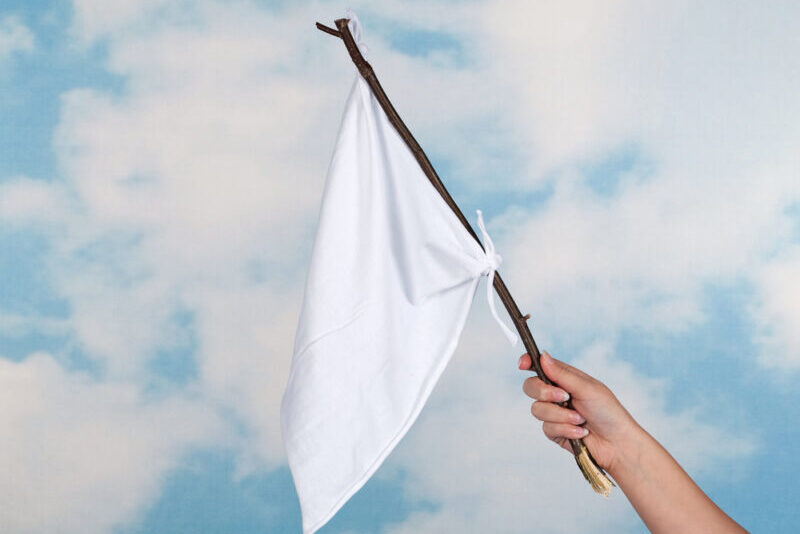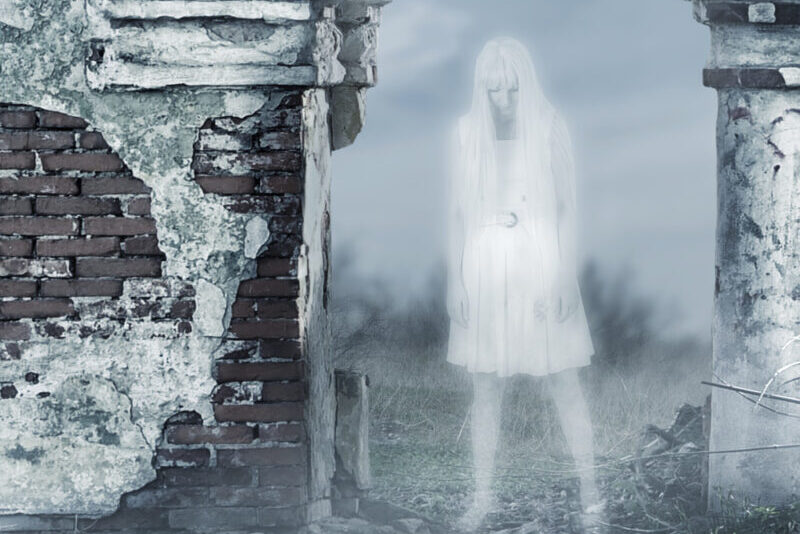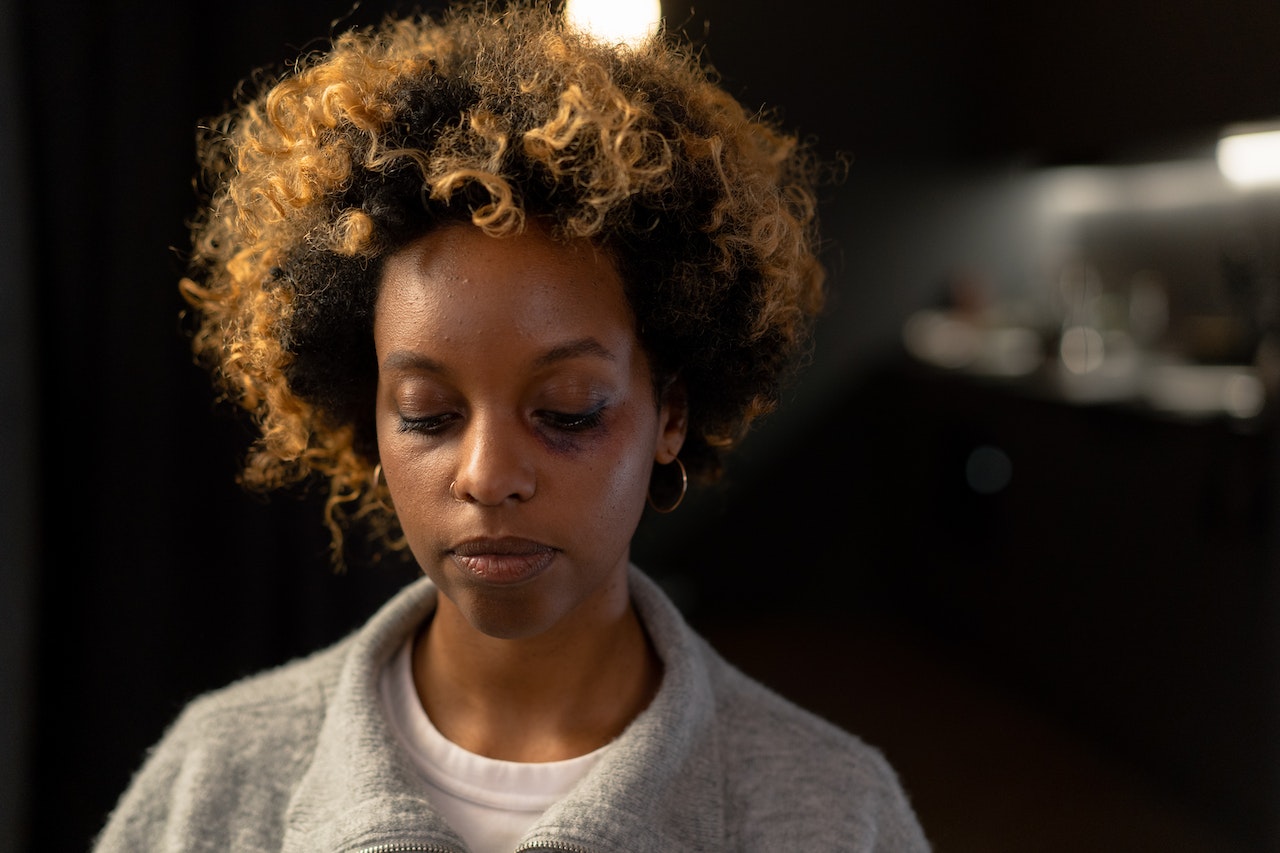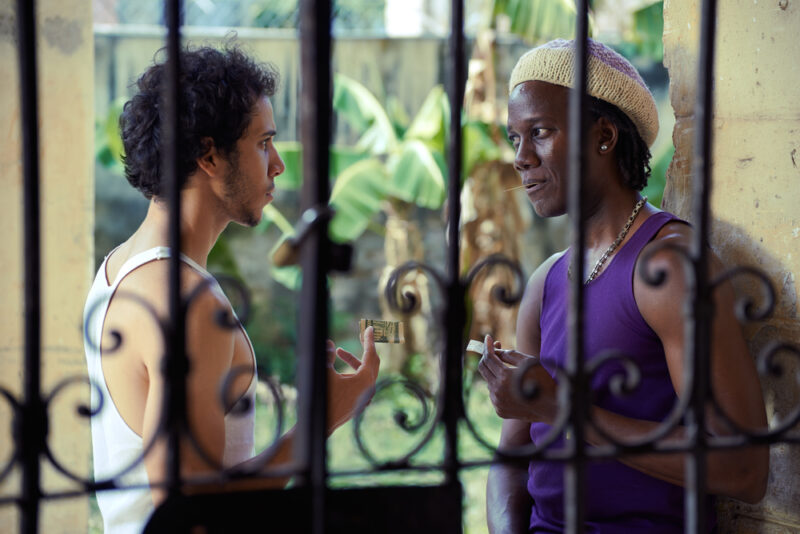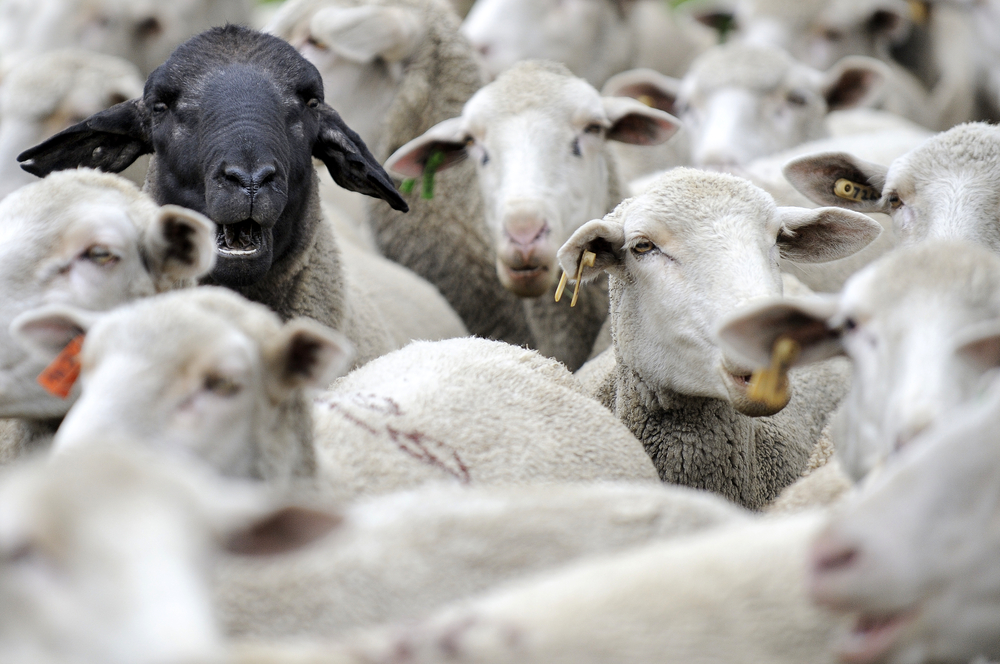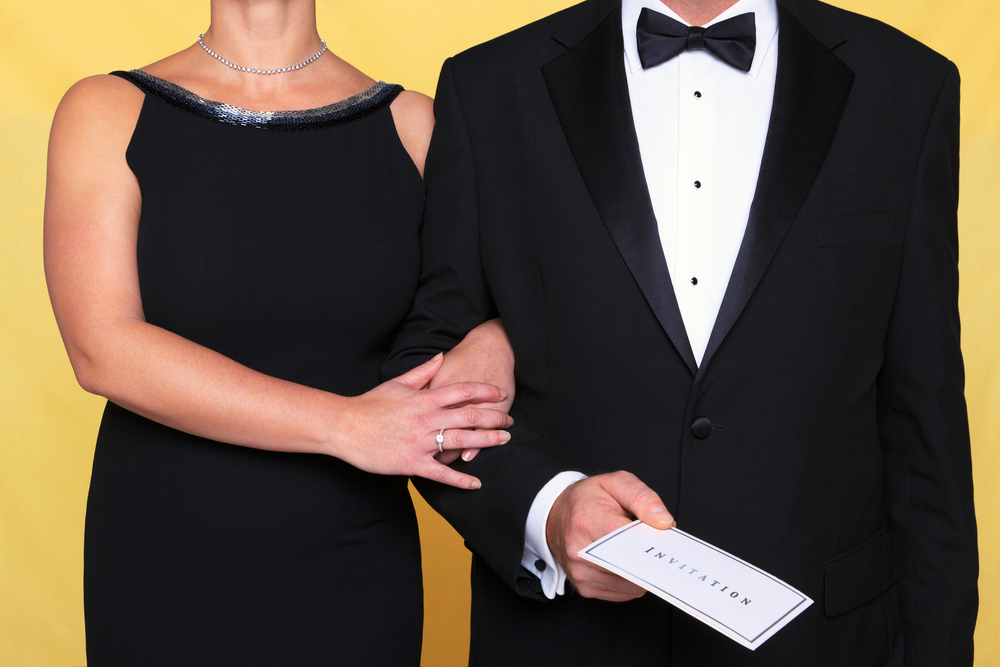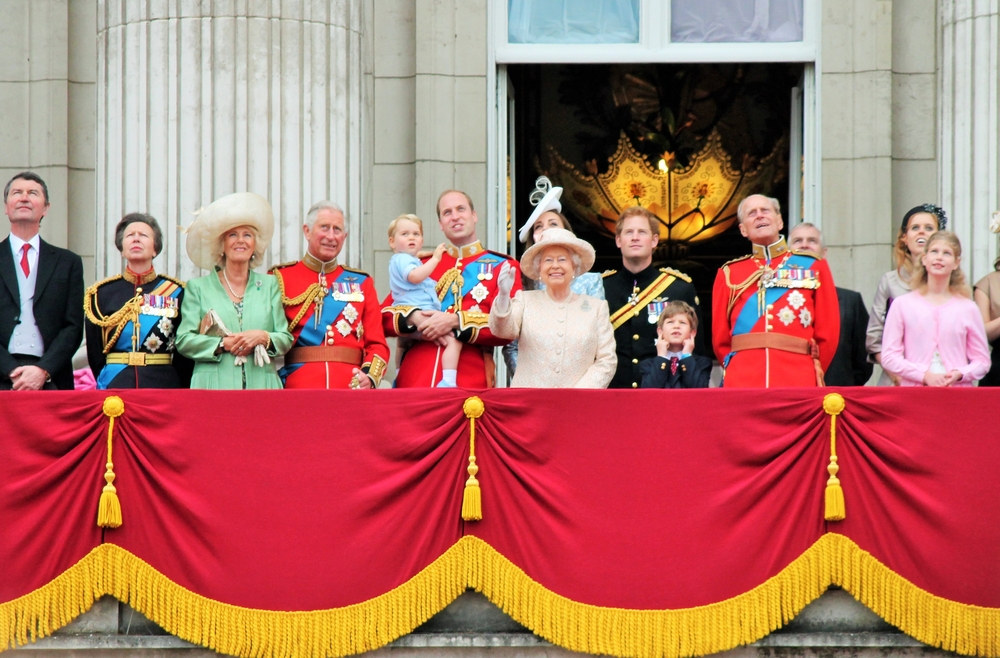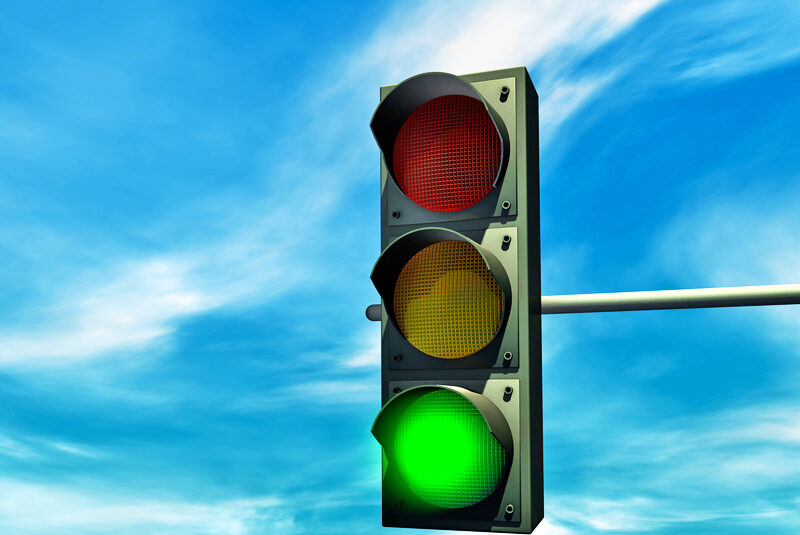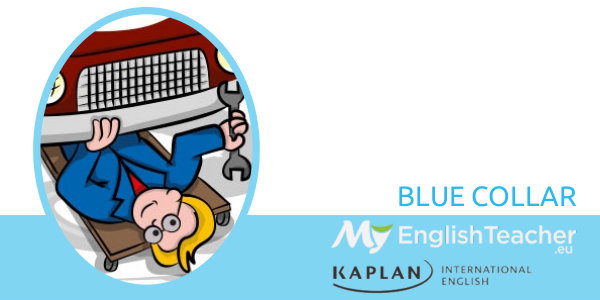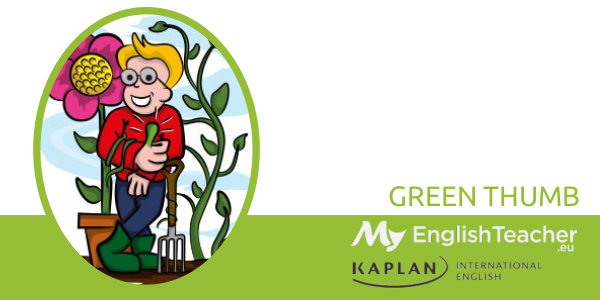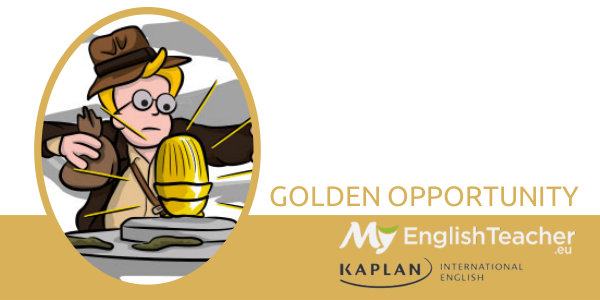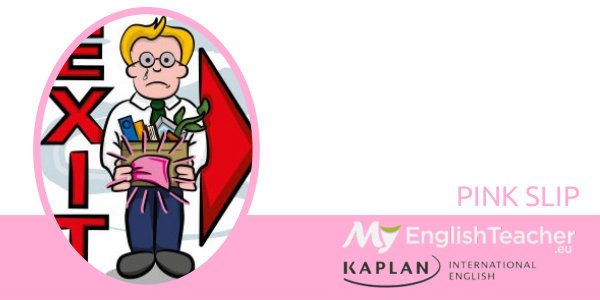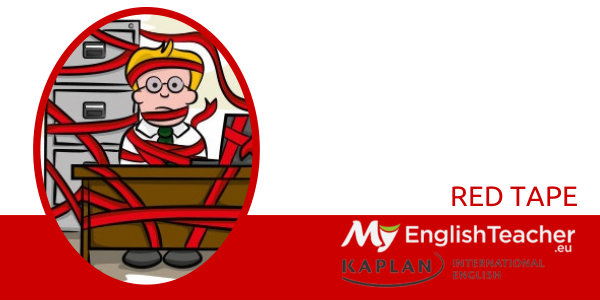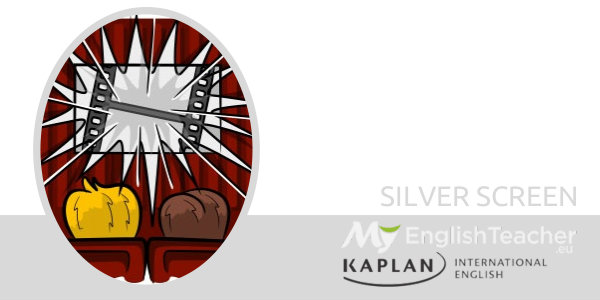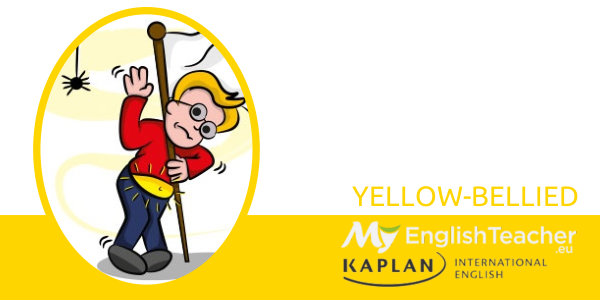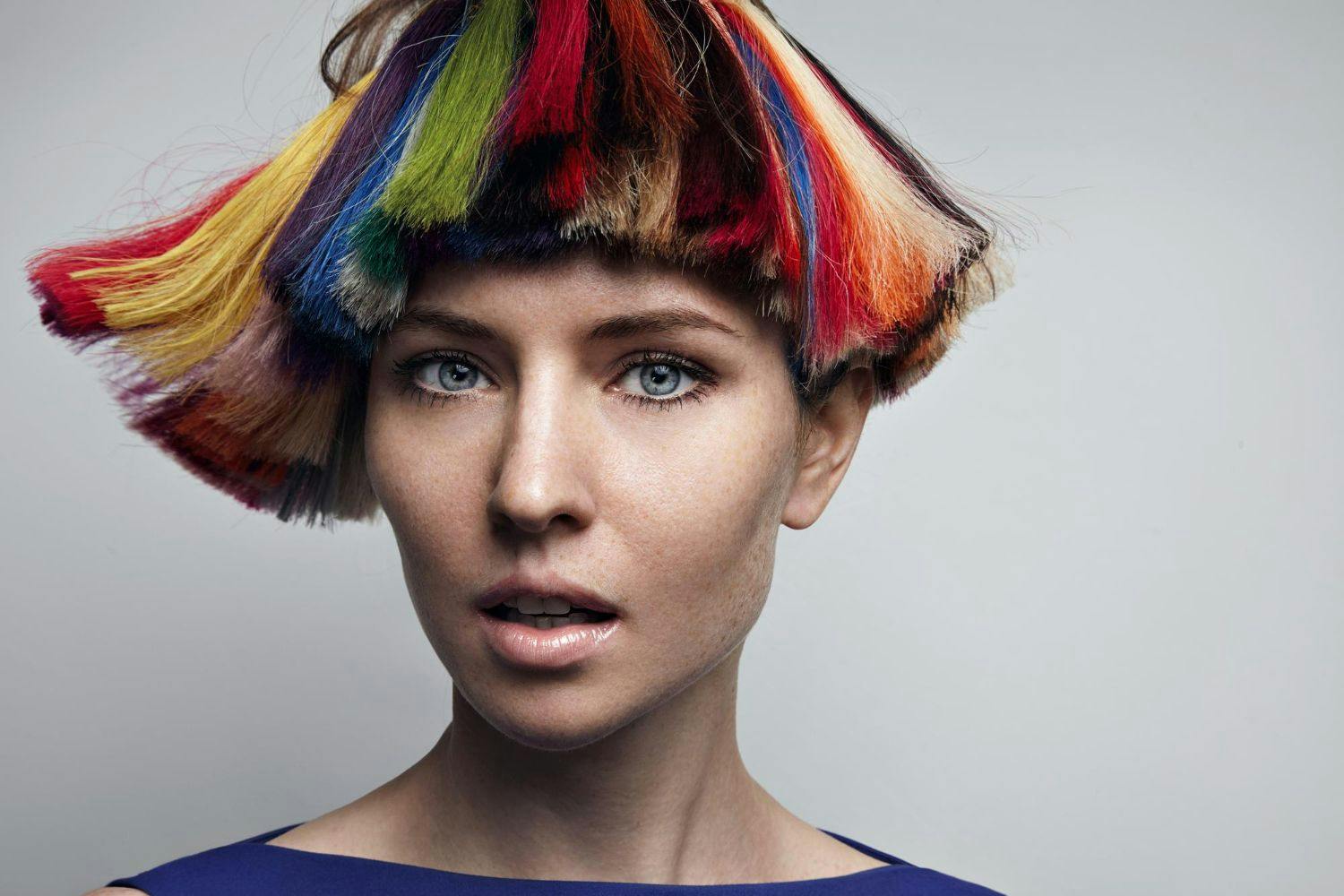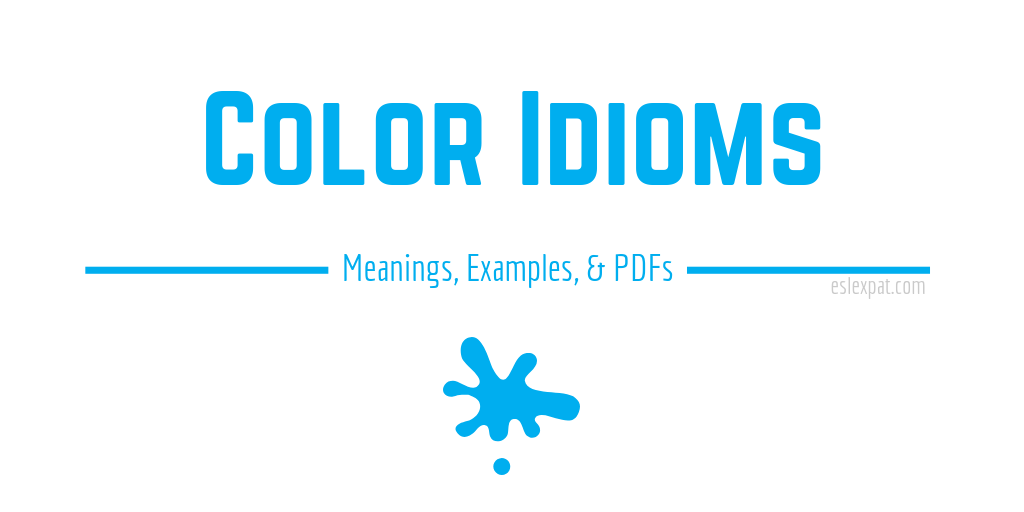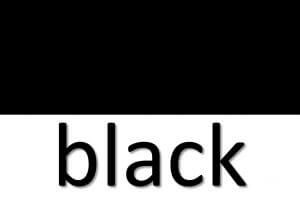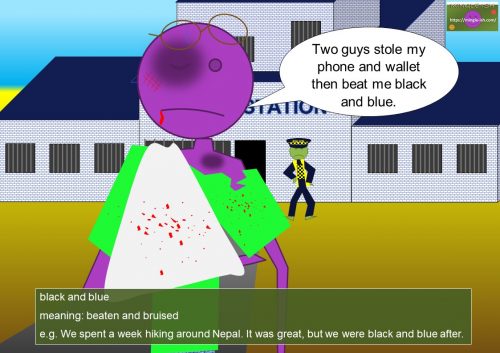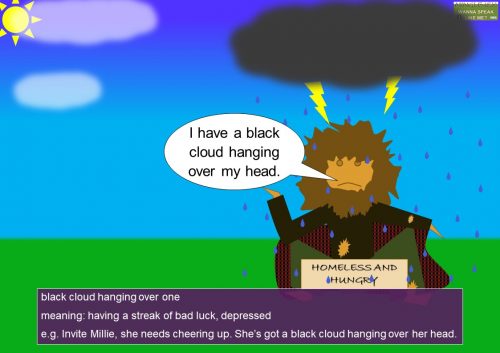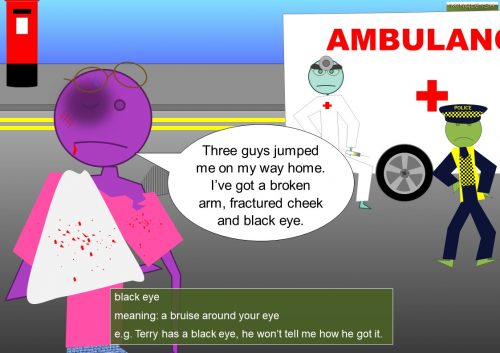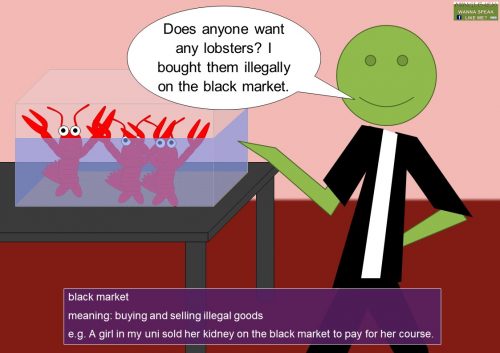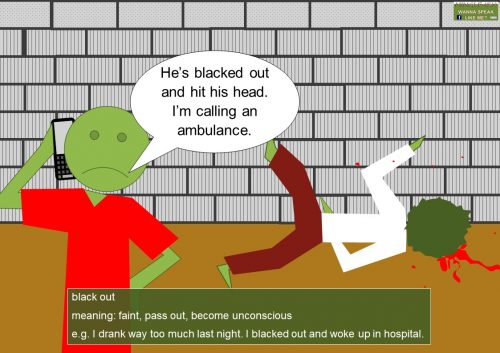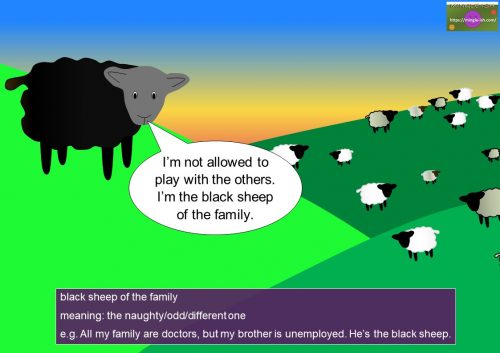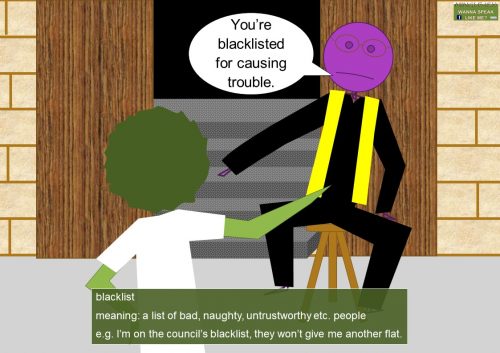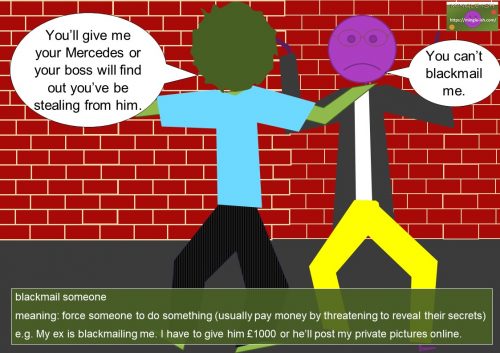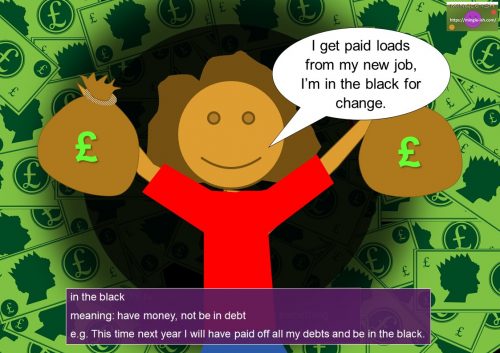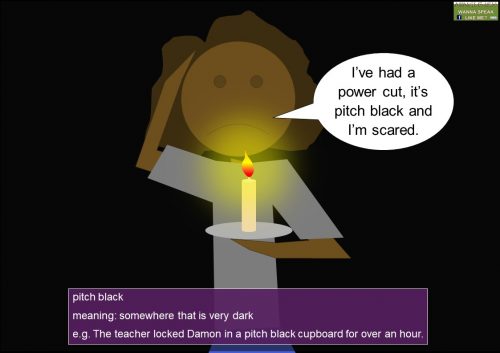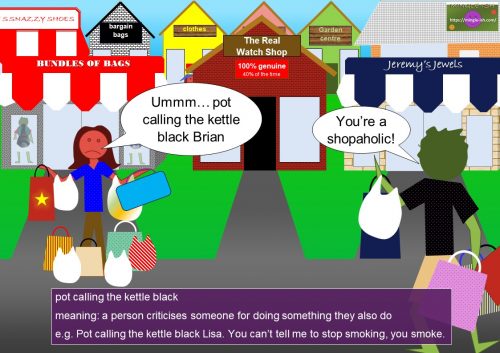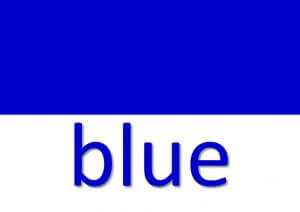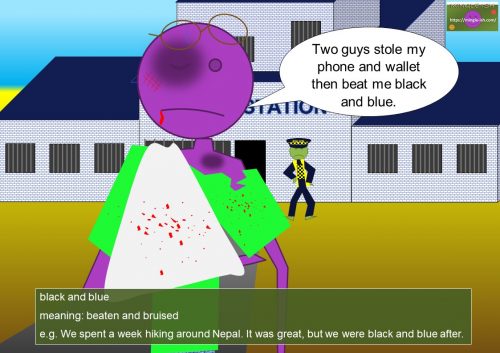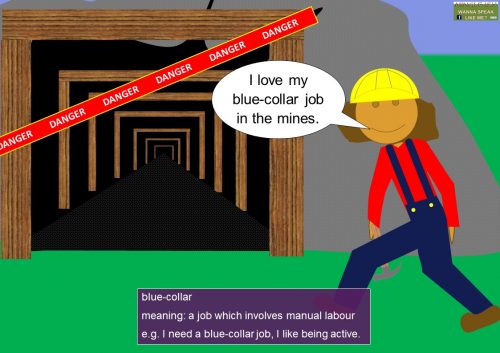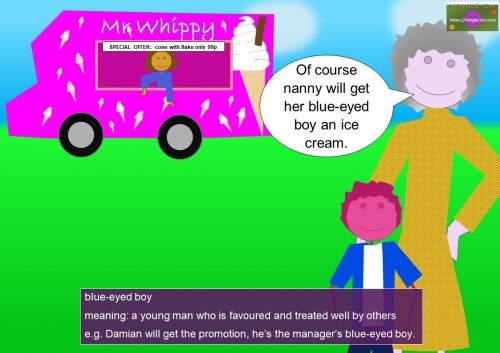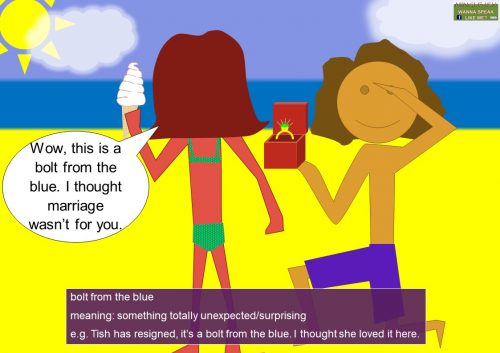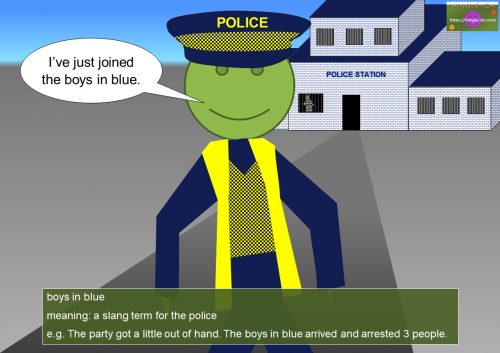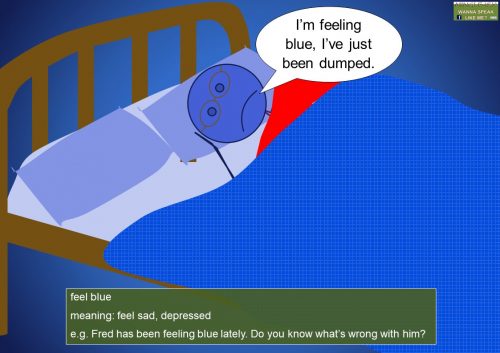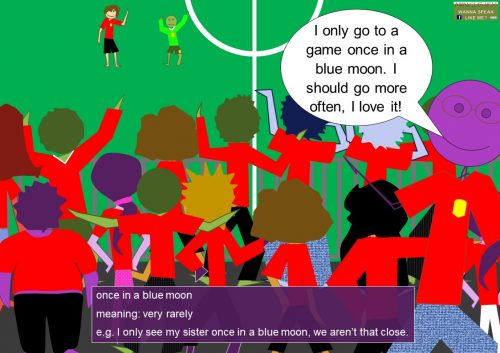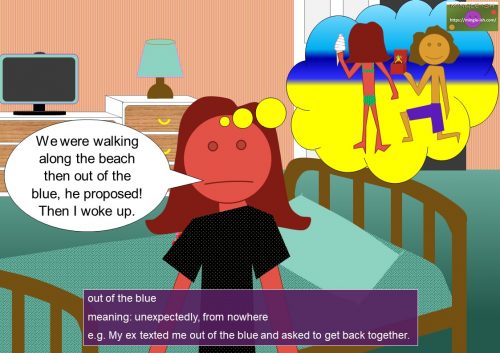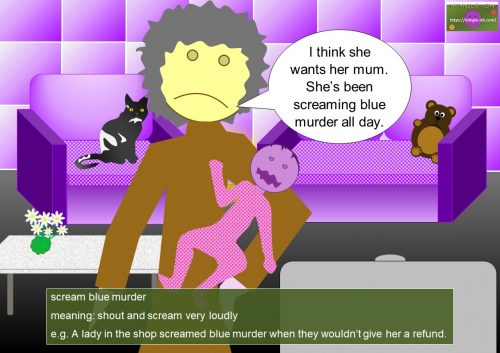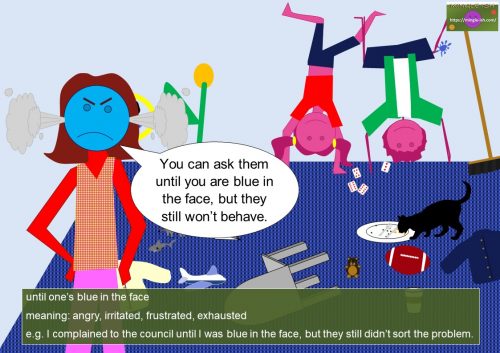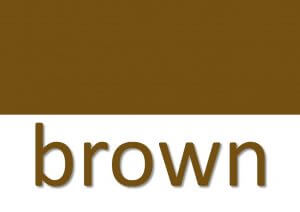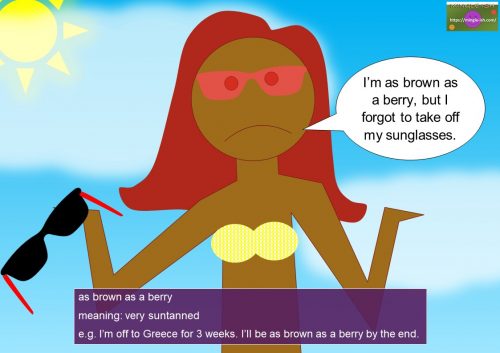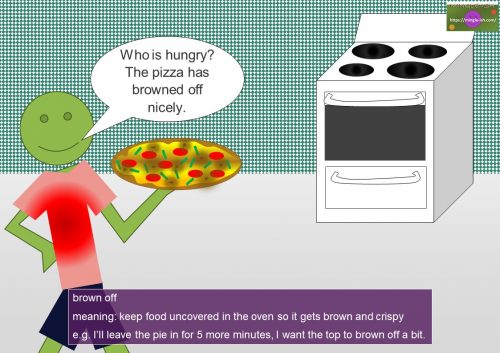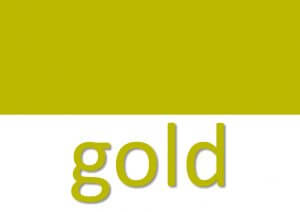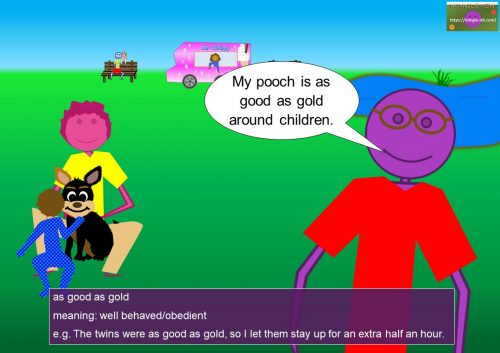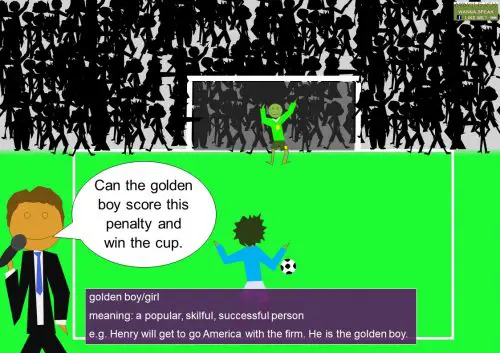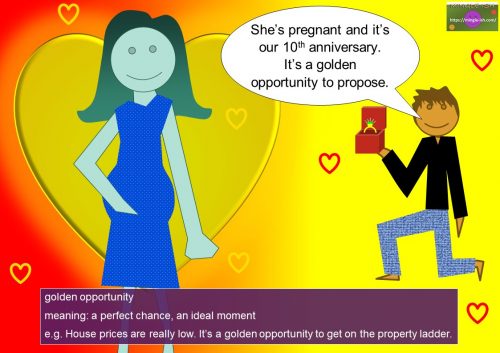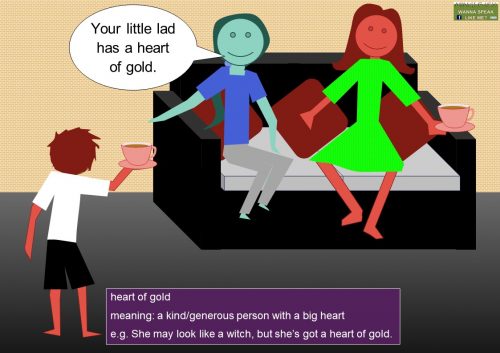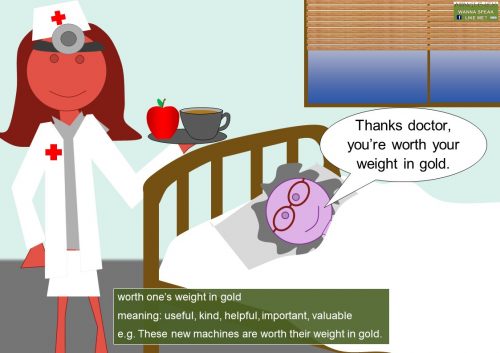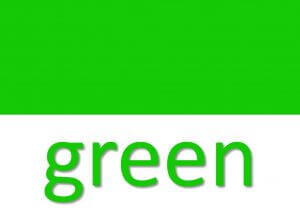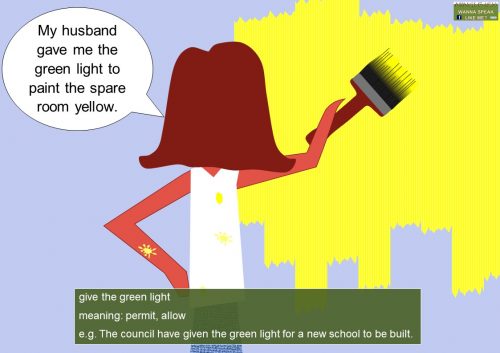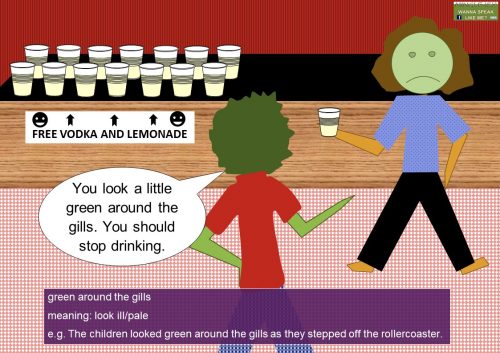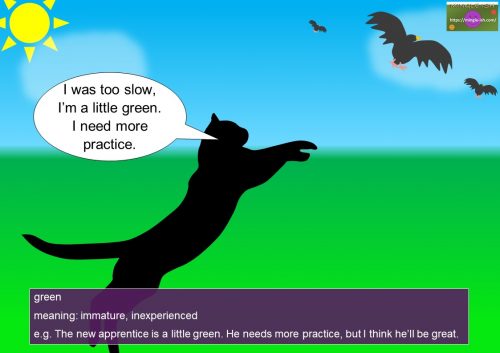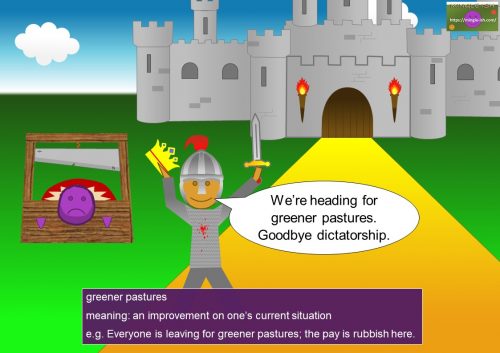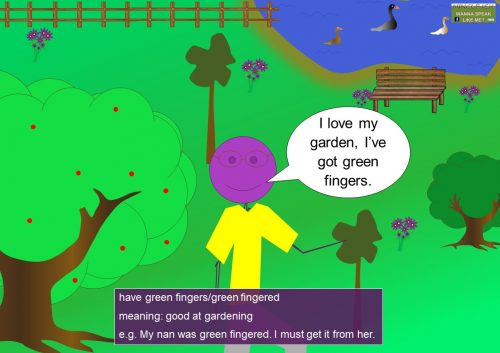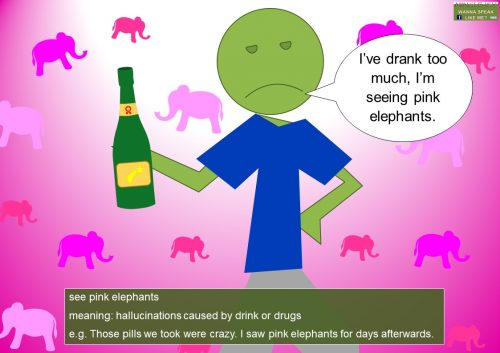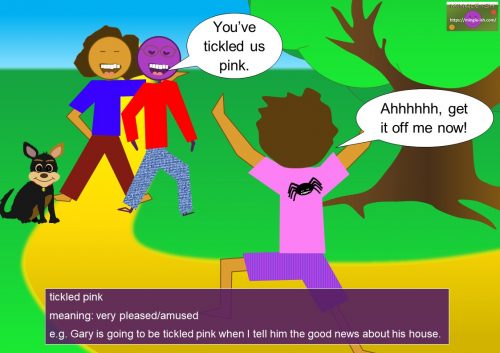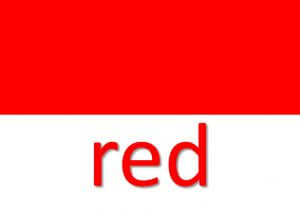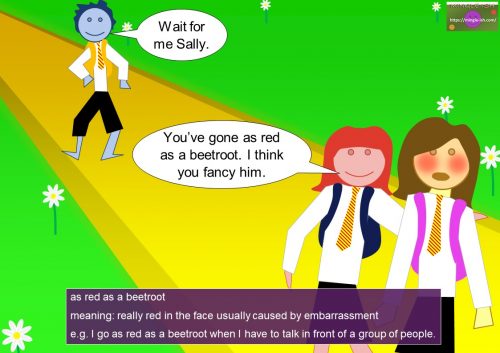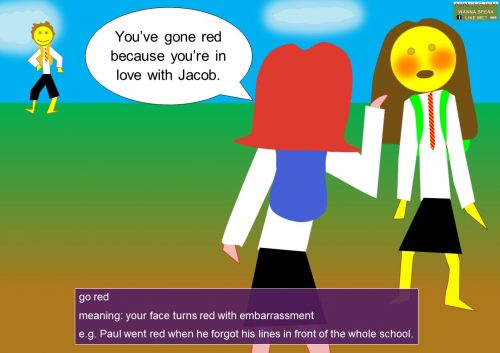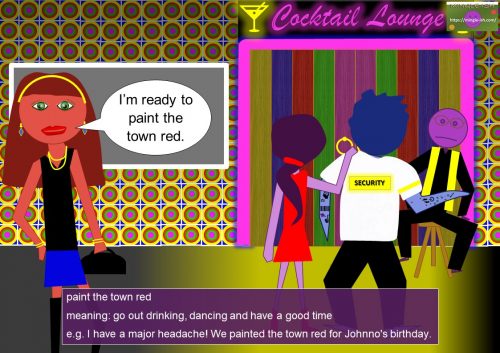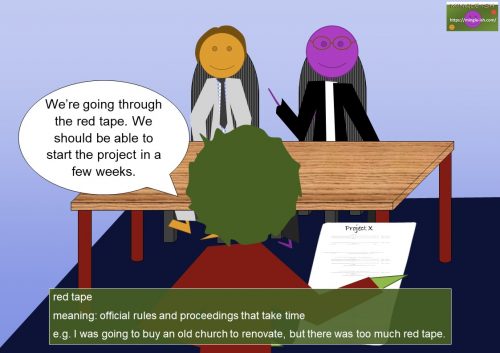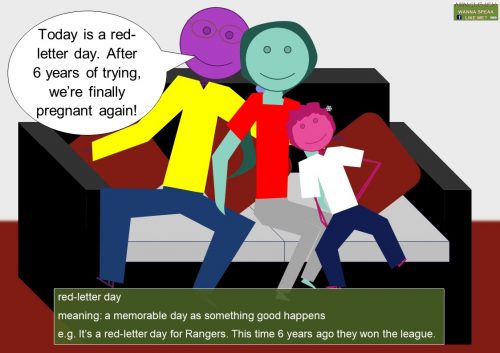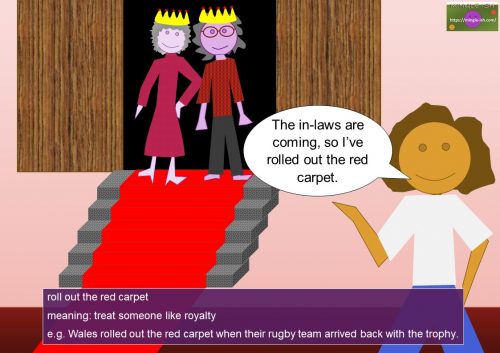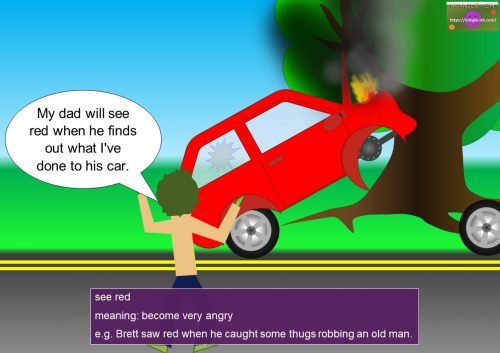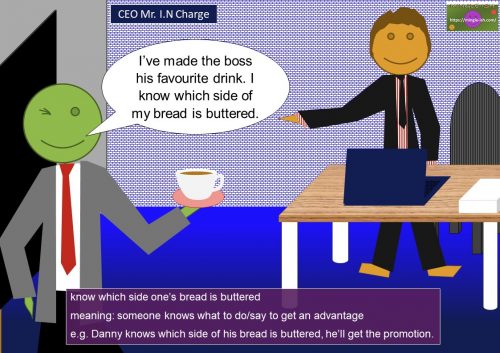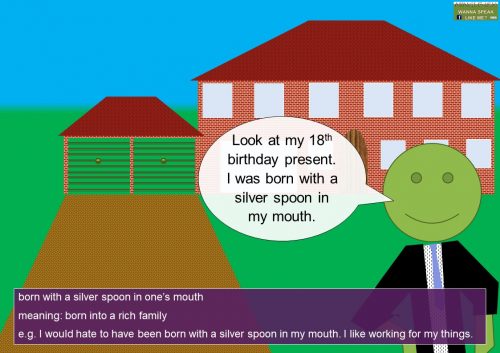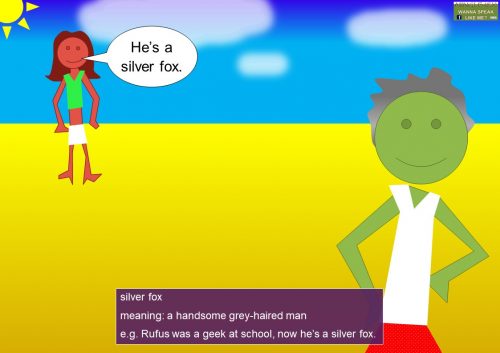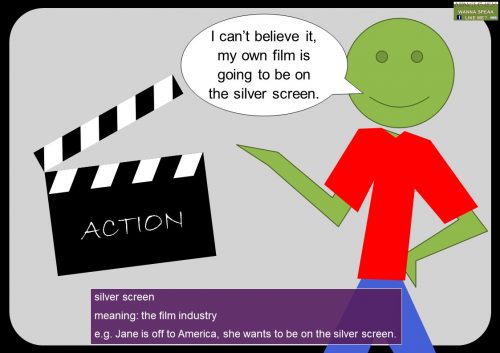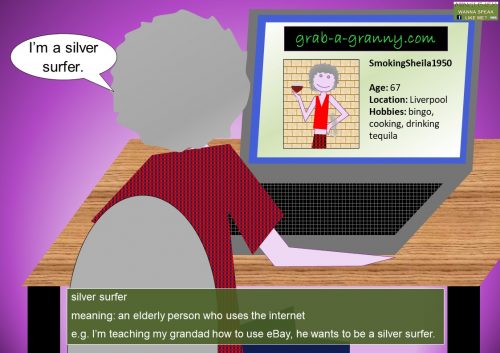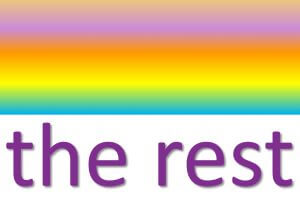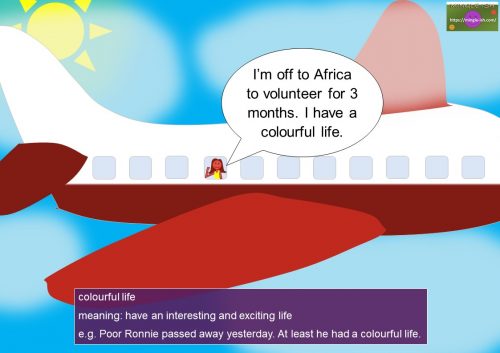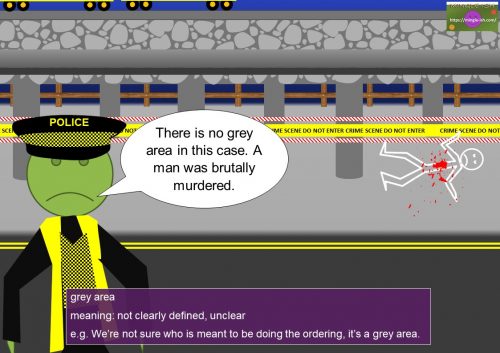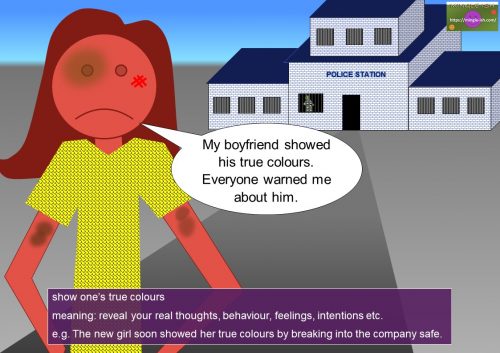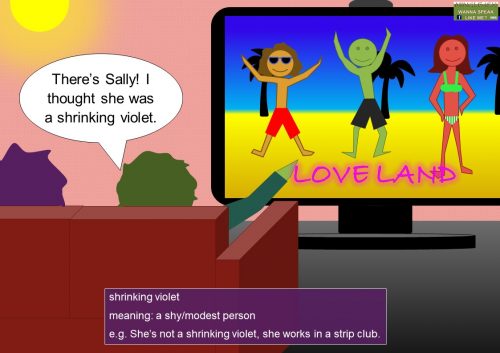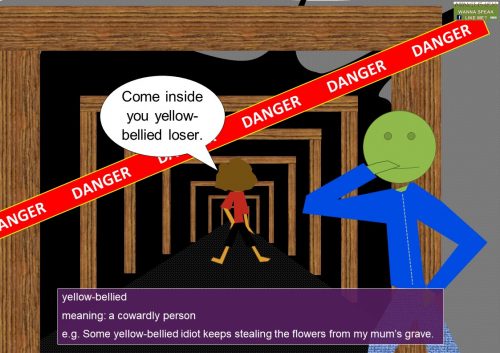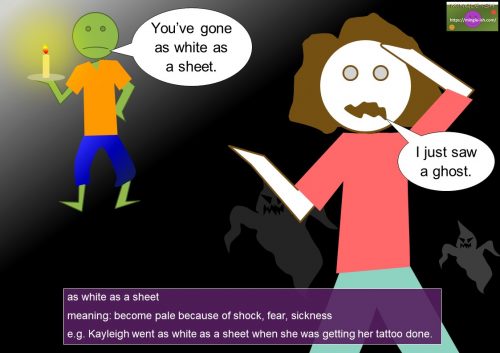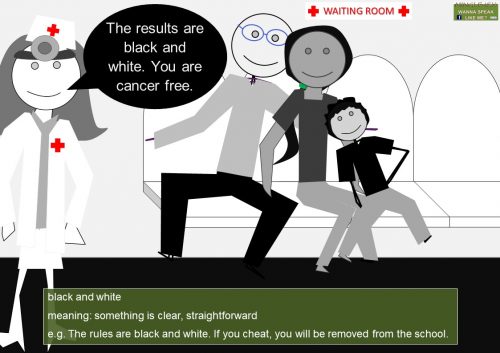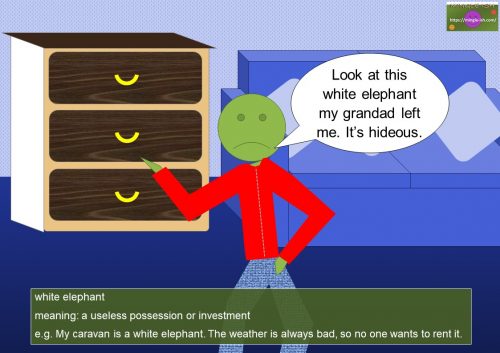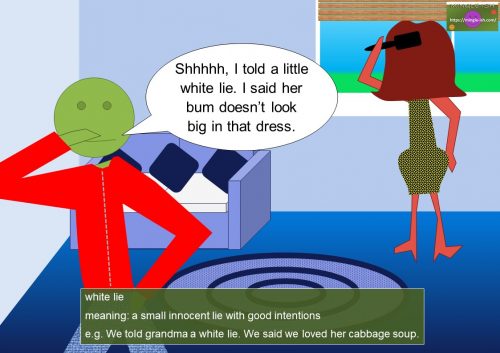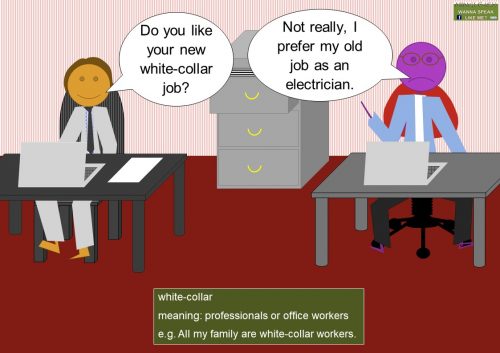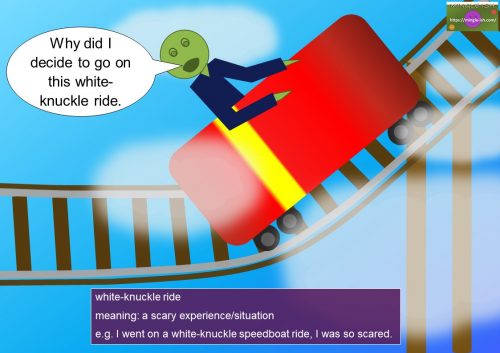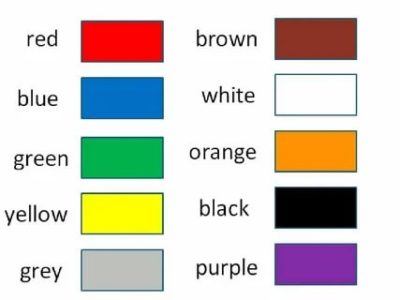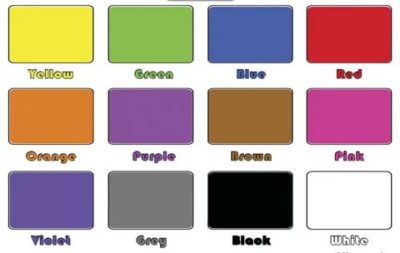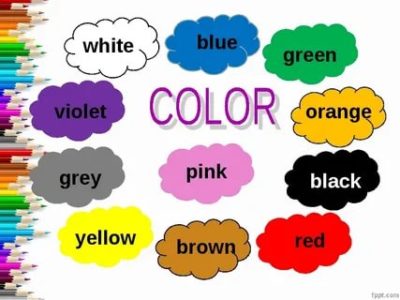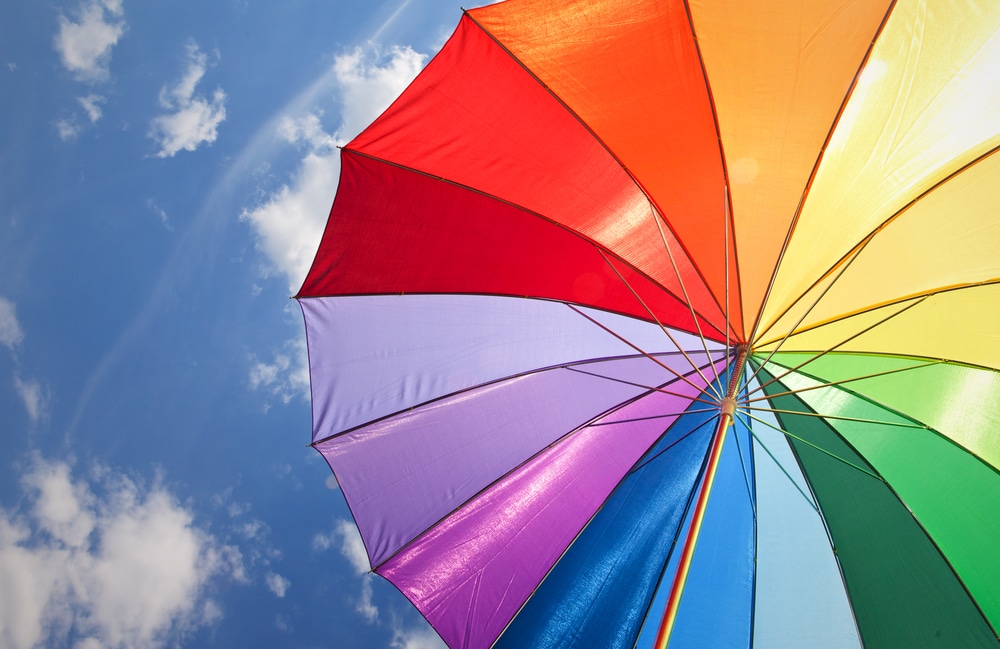
By
Last updated:
October 8, 2022
Like any language learner, you’re probably aiming to sound more like a native speaker.
Learn to express yourself with color idioms for a whole rainbow of rich English vocabulary!
These idioms are used a lot, so you’ll sound more natural than ever.
Contents
- Common English Color Idioms to Liven Up Your Vocabulary
-
- White Idioms
-
- “To wave a white flag”
- “As white as a ghost”
- “To tell a white lie”
- Black Idioms
-
- “As black as coal”
- “Black and blue”
- “Black eye”
- “Black market”
- “Black sheep of the family”
- “Black tie event”
- Blue Idioms
-
- “Feel blue”
- “Blue blood”
- “Out of the blue”
- Red Idioms
-
- “Catch someone red-handed”
- “To paint the town red”
- “A red flag”
- “Red hot”
- “Red tape”
- “Roll out the red carpet”
- Green Idioms
-
- “Get the green light”
- “Green thumb”
- Why You Need to Know These Colorful Idioms
Download:
This blog post is available as a convenient and portable PDF that you
can take anywhere.
Click here to get a copy. (Download)
Common English Color Idioms to Liven Up Your Vocabulary
Idioms are expressions that cannot be taken literally (exactly). They are metaphorical. For example, if a person is “green with envy,” their bodies aren’t the color of a lizard—it’s just a phrase. It means that they’re jealous.
Here are a few of the most popular color idioms in US English:
White Idioms
“To wave a white flag”
Meaning: To show that you’ve lost (a game, challenge or war) and you give up.
Waving a white flag actually dates back to wartime. When one army was losing and they were afraid of losing more men, they waved a white piece of material in the air to show they wanted to stop fighting.
Usage: While I was arguing with my mom about the party I waved a white flag. There was no point in arguing. She wasn’t going to change her mind.
“As white as a ghost”
Meaning: To describe a person’s face being very pale (white) because they’re shocked or scared.
Usage: My friend turned as white as a ghost when she realized there was a stranger standing at her bedroom window.
“To tell a white lie”
Meaning: To tell a small lie that doesn’t hurt another person.
Usage: We had to tell our mom a white lie about the money. We couldn’t let her know we’d spent it all on chocolate.
Black Idioms
“As black as coal”
Meaning: To be very black. Coal is a small piece of carbon used to burn on fires.
Usage: There were many clouds last night and the sky was as black as coal.
“Black and blue”
Meaning: Very beaten up and bruised. Bruised is when you have dark blue or black marks on your body from hitting an object hard or being hit by another person.
Usage: After John lost the wrestling match, he was black and blue. The other guy was very strong.
“Black eye”
Meaning: When the area around your eye looks very black because it has been hit.
Usage: When Mel fell down and hit her face on her brother’s toy truck, she got a black eye.
“Black market”
Meaning: The area where illegal things such as drugs and guns are bought and sold.
Usage: People who can’t buy a gun legally with a permit usually can buy one on the black market.
“Black sheep of the family”
Meaning: A person who is different (usually in a negative way) from the rest of the other family members.
Usage: Al is the only one in his family who hasn’t gone to college. He’s the only one who doesn’t have a proper job. He’s considered the black sheep of the family.
“Black tie event”
Meaning: A formal event or party where men are expected to wear a black suit with a tie. Women are expected to wear long, formal dresses.
Usage: The Oscars is one of the world’s most famous black tie events.
Blue Idioms
“Feel blue”
Meaning: To feel sad or depressed about something.
Usage: Can you call Sally and try and make her laugh? She’s feeling blue after Mike left.
“Blue blood”
Meaning: If a person has blue blood, they come from a wealthy or royal family.
Usage: It’s no surprise he likes to go to the opera. He’s got blue blood.
“Out of the blue”
Meaning: Something happens unexpectedly (by surprise or without warning).
Usage: Mary just showed up at the house out of the blue yesterday. We thought she was still in Europe.
Red Idioms
“Catch someone red-handed”
Meaning: To catch a person doing something they were not supposed to be doing.
Usage: We caught Jake and Julia red-handed. They were hugging and kissing even though they deny it (say it’s not true).
“To paint the town red”
Meaning: To go out and have a good time partying.
Usage: Our exams are finished. Now it’s time to go out, celebrate and paint the town red.
“A red flag”
Meaning: A sign that something that is not right. A warning sign.
Usage: Even though there were red flags in the relationship, Alice ignored them. Now she’s getting a divorce.
“Red hot”
Meaning: To be in high demand, something that everybody wants.
Usage: When iPhones first entered the market, they were red hot. Shops sold them all quickly, and people had to wait to buy their new phones.
“Red tape”
Meaning: Too much formal paperwork to do something.
Usage: When people apply for a visa for another country, there’s usually a lot of red tape.
“Roll out the red carpet”
Meaning: To greet and welcome a person with a lot of respect and celebration.
This idiom comes from Hollywood! When actors and actresses turn up at a special event, they’re given special treatment, and they walk down the red carpet.
Usage: Simon is the favorite child. Every time he returns home to Australia, his parents roll out the red carpet for him.
Green Idioms
“Get the green light”
Meaning: To get the sign that it’s now okay to do something. To be given permission.
Usage: After two years of waiting, the Smith family was given the green light to build a house on their land.
(Cultural note: In many countries in the West, you have to get special building permission to build on your land. It can take a very long time sometimes.)
“The grass is always greener on the other side of the fence”
Meaning: The idea that things are always better in another place. Everything is better than a person’s current situation.
Usage: Many people still see America as the land of dreams. But what they don’t realize is that the grass isn’t always greener on the other side.
“Green thumb”
Meaning: Talent for gardening and working with plants.
Usage: My grandmother has a real green thumb. Every sunny day, she’s outside planting more flowers in her garden.
Why You Need to Know These Colorful Idioms
The key to speaking more like a native English speaker is to use and understand everyday English expressions.
There’s slang, and then there are idioms. Both are very fun ways to boost your English vocabulary and cultural knowledge.
One of the most popular themes for idioms is color.
Color is used everywhere in the world to convey (give) meaning, and it symbolizes different things in different countries. In the US, the color of death and mourning is black, while in China it’s white.
Quite often, a color is connected to a feeling or state of mind. Color is also used in expressions to brighten up our language and make it more interesting.
English is an extremely colorful language. It has many ways of expressing the same ideas, so having a diverse vocabulary is important.
The idioms above are just a few examples of our colorful language. When you begin to understand everyday idioms, you’re one step closer to sounding like a native speaker!
Download:
This blog post is available as a convenient and portable PDF that you
can take anywhere.
Click here to get a copy. (Download)
Add colour to the English language by using these wonderful idioms! Keep your fellow students guessing by using a new idiom each day!
Below is a list of idiomatic expressions related to colour:

This “Colour Idioms” image was created by Kaplan International. Click here to see the original article or to discover how you can study English abroad.
BLACK IDIOMS
1. Black and white
To take everything into consideration and oversimplify something. To judge everything as either one way or the other, good or bad.
- Our boss always thinks that everything is straightforward, but he doesn’t realise that this whole situation is not as black and white as he thinks!
2. Put something down in black and white
To write or have something written down on paper for confirmation or evidence
- I don’t understand why you don’t believe me! Look, it’s written here in black and white!
3. Black as night
Somewhere very dark, when it is hard to see anything
- We had another power cut last night; it was as black as night in our house. We didn’t even have any candles!
4. Black and blue
Used to describe something that is badly bruised
- John’s face was black and blue after the boxing match.
5. Black eye
A bruise near one’s eye
- Fred came home with a horrible black eye today, but he won’t tell us what happened!
6. Black out
This means to, either darken by putting out or dimming the lights, or to lose consciousness.
- We had a huge black out here last night, the whole town was out of power for about 7 hours!
- I don’t know what happened to him, he just blacked out! Maybe he banged his head.
7. Black as a skillet
Used to describe something that is very dirty, black with dirt
- My hands and clothes were as black as a skillet, and I was only halfway through cleaning your garage!
8. Black market
A term used for places where goods are illegally bought and sold for a profit.
- Jerry used to sell cigarettes from South America on the black market!
9. Blackball someone
To exclude or ostracise someone socially, reject them
- Their company has been blackballed ever since that scandal was all over the newspapers. No one wants to do business with them anymore.
10. Blacklist someone
To write someone’s name on a list if they break any rules, and ban them from having the opportunity to take part again
- “I was in a lot of debt a while ago, and was unable to pay it all back, so I’ve been blacklisted. I’m not allowed to get a mortgage in my own name.
11. Pot calling the kettle black (shorten version: pot kettle black)
This is used when the person who hypocritically criticises or accuses someone else is as guilty as the person he or she criticises or accuses
- She kept telling me that I shouldn’t do that, but that’s like the pot calling the kettle black, as she does it herself too!
12. Blackmail someone
To extort or take money from someone by using their secrets against them and threatening to reveal it to others
- He has been blackmailing me for months with some photos that I didn’t know he had. I need someone to help me stop him!
13. In someone’s black books
To be in disgrace or in disfavour with someone
- After that argument yesterday, I assure you he will be in a lot of people’s black books for quite some time!
14. Black tie event/affair
A formal event where male guests wear black bow ties with tuxedos or dinner jackets
- The award’s ceremony will be a black tie event, so I’ll have to buy a smart suit. My wife is going to wear her purple ball gown.
15. Black sheep
Used to describe a person who is the ‘odd one out’ of a group, and doesn’t fit in with others around them. This could also be used to talk about someone who is a disgrace or embarrassment to their group.
- I have always been the black sheep in my family, I have a completely different personality to all of them, and we don’t even look the same!
16. In the black
Meaning successful or profitable
- Their company has been in the black ever since the new CEO took over, and changed it all around!
17. Pitch black
Another term for somewhere that is very dark, and you are unable to see anything
- I was afraid to go downstairs, the whole house was pitch black, and very quiet.
Skype English Lesson with a native AMERICAN or BRITISH teacher ››
Recommended for you:
1000+ Most Popular English Idioms and Their Meanings
50 Popular English Idioms to Sound Like a Native Speaker
BLUE IDIOMS
18. Out of the blue
To appear out of nowhere without any warning, to happen quite suddenly or randomly by surprise
- You won’t believe it but Sarah called me out of the blue yesterday, and told me she’s coming to visit! How unexpected!
- Greg has decided to quit his job out of the blue, and go travelling for a year!
19. Blue pencil
To censor something, or limit the information that is shared
- The reports about how soldiers were being treated abroad had been blue-pencilled by the authorities.
20. A blue-eyed boy
A critical description of a boy or young man who is always picked for special favours by someone in a position of higher authority.
- He is such a blue-eyed boy! I don’t like that the manager always treats him as if he is special, it is not fair on the rest of us!
21. A bolt from the blue
When some unexpected bad news is received
- It was a complete bolt from the blue for us, we had no idea that they were having problems, let alone getting divorced!
22. Blue blood
Used to describe someone from a noble, aristocratic or wealthy family
- Many of the blue bloods in our town were invited to the royal wedding.
23. Blue ribbon
To be of superior quality or distinction, the best of a group
- A blue ribbon panel of experts were invited to investigate the extraordinary remains.
24. Talk a blue streak
When someone talks very much and very rapidly
- The woman in the hospital bed next to me talked a blue streak all day. I don’t where she got the energy from!
25. Feel blue
When someone looks or feels depressed or discontented
- What’s that the matter with you today? You seem really blue. Is there something you’d like to talk about?
26. Blue in the face
To try really hard to win someone’s agreement, but usually end unsuccessfully
- I kept trying to convince him that it was a good idea until I was blue in the face, but he’s so stubborn, he just kept disagreeing with me!
27. Once in a blue moon
To occur extremely rarely, or only once in a lifetime
- My sister is working in Africa, she hardly ever has the time to call us. My parents only hear from her once in a blue moon.
28. Men/boys in blue
Used to describe the police, because of the colour of their uniforms
- I saw the boys in blue outside our neighbour’s house last night. I hope everything is okay.
29. Blue collar
Used to describe men used as labourers, or factory workers
- The got rid of a lot of the blue-collar workers during the recession. I would say they definitely suffered the most.
Check your Grammar ››
Recommended for you:
AT THE DOCTOR Dialogues and Vocabulary List
Hilarious Homophones. 50 Stupid Writing Mistakes to Avoid
BROWN IDIOMS
30. Browned off
To be bored or annoyed with someone or something
- I’m always browned off when he comes to visit. He doesn’t like doing anything, and he hardly ever talks to anyone!
COLOURLESS IDIOMS
31. To be colourless
Used to describe someone who lacks personality, and is really boring
- It’s really hard to make conversation with her. She’s just really dull and colourless.
32. Off colour
When someone is not feeling their best, quite ill or uneasy
- He’s been really off colour for the past few days, I think I might have to take him to the doctor.
33. To give/lend colour to
To help make a story or an explanation more credible and easier to believe, or accompany something
- The broken window and missing items lent colour to her story that someone had robbed her house.
- The music in the play helped to lend colour to the performance of the actors.
34. Sail under false colours
To pretend to be something that one is not
- Our team leader seems to be sailing under false colours, I don’t think he really understands what he’s supposed to be doing!”
35. Local colour
Used to describe the traditional features of a place that give it its own character
- The weekend vegetable market added much local colour to the small town.
36. A highly coloured report
Refers to a report that is exaggerated or has a biased view
- The highly coloured burglary report had to be rewritten when they found out that the police officer who wrote it was a relative of the family.
37. See someone’s true colours
To understand someone’s actual character, often for the first time
- I thought I knew her so well, but it was only until I asked her for the money she owed me that I saw her true colours.
39. See the colour of someone’s money
To prove that someone has enough money for something
- The antiques dealer wouldn’t let me touch the items I’d agreed to purchase, until he saw the colour of my money.
40. Chase rainbows
When someone tries to get or achieve something that is difficult or impossible
- My brother doesn’t think realistically. He’ll never get a decent job if he just chases rainbows all the time.
41. To show one’s true colours
To reveal one’s true nature
- When he got so angry at her in front of everybody, he showed his true colours.
42. With flying colours
To complete something with great distinction, and excellent results
- I didn’t think she would do so well in the final exam, but she passed it with flying colours!
43. Dyed-in-the-wool
Used to describe someone or something that is permanent (like wool that is dyed a certain colour)
- My father has always been a dyed-in-the-wool conservative, and I know he will never change.
44. To paint in bright/dark colours
To describe something in a flattering (bright) or unflattering (dark) way
- John was struggling financially after moving home, but he painted everything in the brightest colours, and made it look like he was absolutely fine!
- She only painted the venue in dark colours, because she wanted to use it for her wedding, and didn’t want me to book it for my wedding!
45. To be kept in the dark
Keeping a secret from someone, shielding the truth
- He kept everyone in the dark about the true extent of his illness.
Skype English Lesson with a native AMERICAN or BRITISH teacher ››
Recommended for you:
SHOPPING Phrases, Dialogs and Phrasal Verbs!
What’s the difference between slang and idioms?
GREEN IDIOMS
46. To be green
Used to describe someone who is immature, or inexperienced
- He can be rather green sometimes. I don’t think he’s ready to be promoted to a higher position yet.
47. Green with envy
Used to describe someone who is extremely jealous, full of envy
- When we were children, my older brother always used to get green with envy if my dad bought something for me and not for him.
48. Give someone the green light / get the green light
When someone receives, or is given, permission to go ahead with something
- We have been given the green the light by the Marketing Executive to go ahead with the new advertising campaign.
49. Grass is always greener on the other side
Used to describe a place that is far away, and better than, where you are now, or another person’s situation that is very different from your own
- He realised that the grass is always greener on the other side when he saw that his new job wasn’t perfect, and had its own problems too.
50. Green belt
An area of fields and trees around a town
- Our city has a policy of increasing the green belt around it.
51. Green thumb/green finger
Used to describe someone with a talent for gardening, having the ability to make plants grow
- This garden used to look so beautiful when my mum lived here. She definitely had a green thumb. I wish I did too!
Check your Grammar ››
Recommended for you:
English Vocabulary for IELTS Speaking Test
280 Basic English Words You Should Know
GREY IDIOMS
52. A grey area
Something that is not clearly defined, and there is still debate as to whether it is ‘black or white’, neither one way or another
- Some of the current rules surrounding bedroom tax in the UK seem to be in a grey area, as many residents disagree with its determining factors.
GOLD IDIOMS
53. A golden opportunity
An opportunity that may never present itself again
- Think carefully about what you’re going to do, this is a golden opportunity, and you don’t want to mess it up!
54. A golden handshake
A large sum of money that is paid to a retiring manager or director, or to a redundant worker
- The company Chairman received a huge golden handshake when he retired.
55. Golden boy
The term given to a young man idolised for a great skill, usually in sport.
- By many of his fans, Wayne Rooney is seen as the golden boy of his football team.
Skype English Lesson with a native AMERICAN or BRITISH teacher ››
Recommended for you:
ESL Apps: 15 English Language Learning Apps for iPhone
Essential Academic Writing Examples and Phrases!
PINK IDIOMS
56. Tickled pink
To be very pleased, thrilled or delighted about something
- Anna was tickled pink that her fiancé had made such an effort for her birthday.
57. See pink elephants
When someone sees things that are not really there, because they are in their imagination
- Anyone who hears his story thinks he sees pink elephants. It’s just such a far-fetched story, and very hard to believe.
58. Pink Slip
A termination notice received from a job
- They gave me my pink slip last week, so I’ve got to find a new job now.
59. In the pink of something
Meaning in very good health
- My grandmother looked ever so well when I saw her, she was in the pink of condition.
Check your Grammar ››
Recommended for you:
112 Phrases for Saying Thank You in Any Situation
15 Business English Idioms and Phrases In Use
RED IDIOMS
60. To be shown the red card
This derives from football terminology, and means to be dismissed from your job
- The company Accountant was shown the red card, after they found out he was using company money for personal gain.
61. To be in the red
To have an overdraft, be in debt to your bank, or owe an institution some money
- I’ve got three credit card bills to pay off at the moment. I hate being in the red!
62. To be out of the red
To be out of debt
- Our company is finally out of the red now. We’ve managed to pay back our loan, and now we’re making profit!
63. A red flag
A signal that something is not working properly or correctly
- The fallen trees along the road raised a red flag for the safety inspectors.
64. Blood red
Used to describe the deep red colour of something
- She was wearing a beautiful cocktail dress with blood red lipstick to match.
65. Beet red
Also used to describe dark red, usually the colour of a face (derives from beetroot)
- I could see my son up on the stage, his little face was beet red!
66. Red hot
Something new and exciting, creating much demand
- The new video game is red-hot. Some fans have been waiting outside stores for days, to get a hold of them!
67. Red herring
An unimportant matter that misleads everyone and draws attention away from the main subject
- Unfortunately that witness was just a red herring. She had no justification to her story, and it was a waste of valuable time.
68. Catch someone red-handed
To catch someone in the act of committing a crime, or doing something wrong that they shouldn’t be doing
- He kept lying to me about where he was going in the evenings, so yesterday I followed him and caught him red-handed. He was with another woman!
69. Red in the face
To become embarrassed
- I went red in the face when the teacher told me off in front of everyone for arriving late!
70. Red-eye
A journey that leaves late at night and arrives early in the morning
- We had to catch the red-eye flight last night, and I’m completely exhausted now.
71. Red-letter day
A day that is memorable because of some important event
- The day I graduated was a red-letter day for my mum, she still talks about it today!
72. To look through rose-coloured/tinted spectacles/glasses
When someone sees things in an overly flattering or over-optimistic light
- Sarah doesn’t understand what it’s like for us. She has always seen everything through rose-tinted glasses because her parents spoilt her so much when she was young!
73. To see red
To react with uncontrollable rage against someone or something
- John saw red when he heard someone shouting at his mother.
74. Red tape
The term used for bureaucratic delay, or excessive formalities, and attention to rules and regulations, often resulting in injustice to the ordinary citizen
- I just want to start my own business, but the amount of red tape involved is so frustrating, that it almost makes me want to give up!
75. To see the red light
To recognise approaching danger. The red light is referred to as a danger signal
- The doctor warned me for so many years that I should stop smoking, but I didn’t listen. When I had a minor heart attack last year, I saw the red light and realised that I had to quit smoking, and improve my health.
76. Paint the town red
To go out and have a really good time at a party
- I’ve managed to get a babysitter for this weekend. Let’s go and paint the town red!
77. Roll out the red carpet
To greet a person with great respect, and give them a big, warm welcome
- When Barack Obama came to visit our school, we rolled out the red carpet for him.
78. Red-carpet treatment
(Similar to the one above) To receive special or royal treatment, and be received with a big, warm welcome
- My aunt always gives us the red-carpet treatment when we go to visit her.
Skype English Lesson with a native AMERICAN or BRITISH teacher ››
Recommended for you:
Useful English Phrases For Running A Business Meeting
Formal and Informal Email Phrases Starting with Greetings
SILVER IDIOMS
79. The silver screen
A term for the cinema
- Do you fancy going to watch that movie on the silver screen tonight?
80. Born with a silver spoon in one’s mouth
Meaning born into a rich family
- I don’t think Kelly has ever had a job. She was born with a silver spoon in her mouth.
81. To be given something on a silver plate/platter
When something is offered to someone whole-heartedly (in a metaphorical sense)
- I offered my heart to him on a silver platter, and he turned it down.
WHITE IDIOMS
82. As white as a sheet
When someone is in a state of great fear or anxiety
- Harold are you alright? You’re as white as a sheet, what’s the matter?
83. Raise a white flag
This indicates that one has accepted defeat and surrenders to the other party
- There was such a heated debate going on in the conference room, they wouldn’t back down! I just raised my white flag in the end.
84. Whitewash something
To cover up or gloss over faults or wrongdoings
- The government was accused of trying to whitewash the scandal over charity pay-outs.
85. White elephant
A term used for a useless possession, something that is of no use
- My mum bought a new CD player for me, but it’s a white elephant. I don’t need it, I don’t even have any CDs!
86. White as a ghost
Used to describe someone who is very pale because of pain, fear, shock or illness
- I didn’t think the movie was that scary, but my sister was as white as a ghost!
87. A white lie
A ‘little’ or ‘harmless’ lie told in order to be polite and avoid hurting someone’s feelings, or do something that is not seriously wrong
- I just wanted to get out of work so I told my boss a little white lie, and said I had a doctor’s appointment.
88. White collar
A term used for office workers that traditionally wear white shirts with a collar.
- We have a lot of vacancies for white-collar workers at the moment, but hardly anyone is applying for them!
Skype English Lesson with a native AMERICAN or BRITISH teacher ››
Recommended for you:
Advanced English Grammar and Vocabulary Test
Order of Adjectives: Explanation + Exercises
YELLOW IDIOMS
89. Yellow-bellied
Someone who is seen as a coward or extremely timid
- There is no point in asking him what to do. He is a yellow-bellied coward, and won’t stand up for what is right!
90. A yellow streak
Someone who has cowardice in their character
- He has always had a big yellow streak running down his back, don’t expect him to change now!
33 Color Idioms And Expression To Brighten Your Speech
18 min
Created: January 17th, 2023Last updated: March 31st, 2023
Contents
English is a language full of idiomatic expressions. It abounds with sayings that might not make literal sense, but convey a deeper meaning, often based on cultural references. These little turns of phrases create vivid images in our minds and can be used to communicate a range of emotions more effectively than literal language. One way that English does this is by incorporating references to colors. Colorful idioms can spice up your speech and make it more interesting, not to mention more fun.
If you want to add brilliance to your English conversations, this article is for you! We will look at some of the most popular color-based idioms in the English language. Furthermore, we will provide some example sentences to help you see how to use these expressions.
What are colorful idioms?
An idiom is a phrase that has a meaning which is not literal. In other words, when you use an expression, you are not saying exactly what the words mean. For example, if somebody says to you, “I’m pulling your leg,” they will not grab your limb and tug on it! Instead, this person is joking with you or trying to mislead you.
There are thousands of idioms in English, many of which refer to colors. It is thought that this is because colors are often used to describe an emotion, providing a quick and effective way to communicate a feeling or message. The use of color in the language is not limited to idioms. You will also find color proverbs, metaphors, and similes.
You will notice color idioms appearing in daily conversations as you learn English. You might also see them in books, films, and TV shows. And, of course, you can add some life and vibrancy to your English conversations once you start using them!
33 color idioms and expressions
This list showcases some of the most popular idioms that involve color. We have included an example sentence with each idiom to help you understand how it is used. Also, remember that some phrases can be used differently and possess several meanings.
- To show your true colors.
If someone is showing their “true colors,” they are revealing their type of person, either positive or negative characteristics that have been hidden previously. The phrase is often used to show the unmasking of someone’s real character.
The man had always seemed pleasant and kind but soon showed his true colors by being rude to the waiter.
She always appeared perfect and put together, but her true colors started to show when she was under pressure.
- To pass with flying colors.
To “pass with flying colors” means to succeed and surpass expectations in an endeavor or challenge, usually an exam. It suggests such excellence that the person is seen as victorious – like a soldier returning home with their flags intact!
She was worried about going into her test, but she passed with flying colors; she got one of the highest grades in the class.
Melanie worked hard to prepare for her presentation and passed with flying colors, much to the delight of her boss.
- To look for/see the silver lining.
If you are “looking for the silver lining,” you are trying to find a positive result or outcome from a difficult situation. The phrase is derived from how clouds often part and reveal rays of silvery light when the sun begins to shine.
This economic crisis may have put us in an unpleasant situation, but we must keep looking for the silver lining – try not to be disheartened!
The exam was challenging, but I’m looking for the silver lining – hopefully, my hard work will pay off.
- The silver screen.
The term “the silver screen” refers to the movie industry. It is often used to convey a sense of glamor or nostalgia about the cinema.
He was one of the most successful directors in Hollywood, and his movies impacted the silver screen for years.
John became famous overnight after his performance on the silver screen made him a star.
- Born with a silver spoon in one’s mouth.
This phrase is used to describe someone who was born into a wealthy or privileged family. People born “with a silver spoon in their mouth” often enjoy certain advantages or luxuries simply due to their parents’ wealth.
He had always been used to having things handed to him – he was born with a silver spoon in his mouth.
Although she grew up in poverty, she was determined to make something of her life and show that she didn’t need a silver spoon to be successful.
- Black sheep.
This is one of the phrases with colors that carries a negative connotation and is used to describe somebody who stands out from the crowd in a negative way. It could mean that they have behaved poorly or done something wrong, but it can also be used for people who simply don’t fit in and are considered outsiders.
My parents weren’t too happy with my rebellious behavior. I was the black sheep of the family.
He was put down at school for being different and viewed as his peers’ black sheep.
- In the black.
The idiom “in the black” means doing very well financially or having a good money situation. It is the opposite of being “in the red,” typically referring to businesses or companies.
The company was about to close down before they changed their strategy – now they are in the black again and more successful than ever!
He has made wise investments that have put him firmly in the black.
- White lie.
A “white lie” is a harmless lie that somebody tells to make another person feel better. It also helps avoid uncomfortable situations or difficult conversations while still trying to preserve the truth.
I had to tell him a white lie and say that his painting was beautiful, even though I thought it was terrible.
She used a white lie to get out of going on a date – she said she had an important meeting that day.
- Black or white.
You may have heard someone say, “It’s black or white; there is no gray area.” This idiom refers to situations with only two possible outcomes – good and bad. The phrase suggests that when it comes down to it, we must decide between these two options without any room for compromise or ambiguity.
It’s black or white – you either agree with us entirely or not!
The choice was clear; it was black or white, so I had no other option but to accept the terms they proposed.
- Raise a white flag.
To “raise a white flag” means to surrender or give up. Sometimes it is used figuratively, especially when referring to arguments between people.
They had been going back and forth for hours, but eventually, he raised the white flag and conceded that she was right.
We couldn’t agree on anything, so in the end, I decided to raise a white flag and forget about it.
- Whitewash something.
When you “whitewash something,” it means that you are trying to cover up the truth or make a situation look more positive than it is. Generally, this phrase carries a negative connotation and implies dishonesty.
The government attempted to whitewash reports of police brutality by denying that any human rights violations had occurred.
They tried to whitewash the scandal, but there was too much evidence against them, and they faced legal action.
- To be blue.
When someone is “blue,” it means they are feeling sad or depressed. This expression is usually understood to indicate a deep sadness that might have been brought on by something out of the person’s control and has left them feeling dejected, despondent, and lonely.
After being laid off from her job unexpectedly, she was blue for months.
My grandmother passed away, and I was so blue afterward – it felt like a part of me had gone too.
- To be true blue.
If someone is “true blue,” they are devoted and loyal to a cause or person. It could also refer to somebody who sticks with their principles, no matter what the consequences may be.
My best friend has always been true blue; she has supported me unconditionally during every difficult situation I have ever faced.
Joe was true blue to his country and worked hard to ensure that it had a bright future.
- To be tickled pink.
“Tickled pink” means that someone is delighted about something. Furthermore, the phrase suggests the person was pleasantly surprised and likely overjoyed by whatever happened to them. This expression can also describe somebody who is simply happy with no outside stimuli necessary!
My grandma was tickled pink when I unexpectedly showed up at her door – she gave me a big hug and had tears of joy in her eyes!
I was tickled pink when Jack told me I had gotten the job.
- In the pink of something.
The phrase “in the pink of something” means to be in perfect health or condition. It implies that everything is going well and can also mean “the height of perfection.”
She felt so good that she declared herself in the pink of health!
My career is in the pink of shape right now; I’m so pleased with how well things are going.
- To give someone the green light.
To “give somebody the green light” is to approve something or encourage a person to move forward with their plans. The phrase is derived from the “traffic lights” system, in which a green light signals that it is safe to continue.
We received the go-ahead from our boss, so we have now been given the green light to begin working on this new venture.
The board of directors gave the green light to my proposal, so I am now ready to start implementing it.
- To be green with envy.
The idiom “to be green with envy” describes someone who feels very envious of another person because of the success or good fortune that they have achieved, whether it be material possessions, wealth, or simply happiness. This phrase implies that the feeling is intense and not easy to contain!
My colleague was so green with envy when I got promoted; she didn’t even congratulate me on my success!
John could barely look at me – he was so jealous after hearing about how well my presentation went – he must have been green with envy.
- To be green.
If somebody is “green,” it means they don’t have much experience or knowledge about something. It often refers to being naive and lacking in wisdom as well.
When he started the job, he was still a bit green – inexperienced with the day-to-day tasks but eager to learn.
She was only 23 when she ran for office, and the other candidates were worried that she was too green to handle the job.
- To have a green thumb.
If someone has “a green thumb,” they are very good at caring for plants, and their gardens grow exceptionally well. This expression can also be extended to any activity that requires someone with a natural affinity or skill for it to thrive.
My mom has always had a green thumb; anytime I go home, her garden is full of beautiful blooms!
Lucy has the perfect eye and touches needed for painting – she has more than just a green thumb in art.
- The grass is always greener on the other side.
This idiom refers to the tendency of people to assume that other situations or lifestyles are more desirable than their own. As a result, people often compare their present circumstances with others and feel discontent when they don’t measure up.
Everyone feels like the grass is always greener on the other side, but usually, they just need to take a step back and appreciate what they have.
From her friends’ Facebook posts, it seemed like their lives were perfect, making her feel that the grass was greener on the other side.
- Black and blue.
If someone is “black and blue,” it usually means that they are bruised or have physical injuries. This phrase implies a person has been in a fight or altercation; it can also be used metaphorically to describe emotional hurt.
The boxer was black and blue from all his blows during the match.
The break-up left her feeling completely black and blue – she thought she would never recover from its effects.
- Once in a blue moon.
This expression is used to describe something that doesn’t happen very often. Usually, it implies the event’s occurrence is rare, and a person may have only experienced it once or twice in their lifetime.
We don’t get snow here anymore – I think the last time was once in a blue moon.
My grandma comes over for lunch every few months. She says it’s a once-in-a-blue-moon treat.
- Out of the blue.
“Out of the blue” suggests that something happened unexpectedly. Usually, it implies the thing that occurred was not planned or expected and may have surprised people.
I received a call out of the blue from my old high school – they wanted me to be a speaker at their graduation!
I was about to go for lunch when, out of the blue, it started pouring outside.
- Golden opportunity.
A “golden opportunity” refers to a chance that might not come again in your lifetime, and you should seize it with both hands. In other words, it is a favorable occasion with immense potential – if you let the chance slip away, who knows when something like this will arise again!
The audition was my golden opportunity; I just had to ace it if I wanted to get selected into the program.
Roger sees this as his golden opportunity for success – he must take all steps necessary to ensure nothing goes wrong along the way.
- A golden handshake.
This phrase describes a large sum of money given as compensation for somebody leaving or retiring from their job. It could also incentivize someone to work hard and stay with the company in exchange for a financial reward.
He negotiated himself a golden handshake when his contract was up – it was double what he had expected!
Jack received a generous golden handshake when deciding to call it quits and retire from his job.
- Golden boy.
This phrase is used positively and primarily refers to somebody who has achieved success early on in life. It could imply that the person is talented and has done something amazing, often receiving praise and admiration from others.
He was always considered to be the golden boy of his family – he was bright, talented, and successful in everything he did.
John was the golden boy of his college basketball team, as no one could challenge him on the court.
- To catch someone red-handed.
This color expression describes somebody caught doing something wrong or illegal. The phrase is believed to come from the idea that someone’s hand would be covered in blood if they had just committed a murder.
The evidence proved that he had committed the crime, so there was no way to deny it – he was caught red-handed!
The police caught the thief red-handed, and he was sent to prison for his crime.
- To paint the town red.
If someone “paints the town red,” it usually means that they are enjoying themselves and having a good time by going out and doing exciting things. People may also use this idiom to describe when they are doing something wild and reckless.
Let’s paint the town red; I feel like going out for a night of fun and adventure!
The group went crazy on their last night in Vegas, painting the town red with wild antics.
- To be in the red.
If somebody is “in the red,” it means that their finances are in a bad state or they are not doing well financially. Most likely, they are in debt or don’t have enough money to cover their expenses.
To earn a living, he had to work multiple jobs, and it still wasn’t enough – he ended up being in the red every month.
The business struggled so much that it went into the red; its debts were more than what it made.
- Red tape.
“Red tape” is one of the color expressions used to describe bureaucratic processes that take too long or cause unnecessary delays. It implies the presence of annoying rules and regulations that can make accomplishing something more complicated than it needs to be.
The government was so inefficient and overcrowded with red tape. I had to undergo months of paperwork before finally getting my permit approved.
Harry faced all sorts of hurdles at work – from never-ending red tape procedures, he just wanted out.
- Red-letter day.
A “red-letter day” is a term that describes an especially momentous or important occasion. These days are special because they signify some achievement or success in someone’s life.
Today was a red-letter day for us at the company – we signed our first major deal.
Jill had been waiting eagerly all week for today; it was her red-letter day as she finished college with perfect grades.
- To roll out the red carpet.
“Rolling out the red carpet” describes the special treatment or hospitality that someone receives. Usually, it means going above and beyond to ensure the person or group feels welcomed and appreciated.
The company rolled out the red carpet for all its new hires – they had a fancy welcome lunch with drinks and desserts.
My daughter’s birthday this year was extra special as her friends rolled out the red carpet and gave her a party to remember.
- A red flag.
This phrase indicates a warning or risk. It implies danger in some form, such as an issue that needs to be addressed or something that could potentially cause a problem. The “red flag” is a marker so people can be aware of potential risks.
The suspicious behavior was the first red flag – I knew something wasn’t quite right, but I couldn’t put my finger on it.
I saw some red flags when investing in this stock. The market was too volatile, and there was too much risk for me to decide.
3
Tips for learning phrases with colours
Using idioms is a great way to demonstrate your fluency in the language and make your English conversations more interesting. However, learning these expressions can be tricky! If you are finding it difficult, here are some tips that could help:
- Use dictionaries to find the explanations. To look up the meaning of an idiom, use a dictionary to check what it actually means in context. That way, you can be sure you understand and use the color expression correctly when speaking with others! Some examples are the Merriam-Webster Dictionary and Cambridge Dictionary, both available online.
- Make a list. Write down all the color idioms you come across and use them in writing or speaking practice. Repeating this list in different contexts will help you commit the color phrases to memory.
- Try some mnemonics. Mnemonic devices are very effective in helping us remember certain concepts, ideas, or expressions. Visualize an image that combines color and the idiom to act as a reminder every time you see that color.
- Look for practical examples. Find movies, sitcoms, and songs in English that use color idioms to give you a better understanding of their meaning. Watching them will also help improve your listening skills.
Now that you better understand phrases about colors and how they are used in English take some time to practice your new language skills. Break out of your shell and start using some idioms in conversations with other English speakers to add life and humor to your interactions.
Improve your English Fluency with Promova
Looking to take your English skills up a notch? Promova is the perfect platform to do so! On our online platform, you can access interactive courses and classes to take your English grammar, writing, and speaking abilities to the next level. Our tutors are all native English speakers, ready to provide personalized help on topics ranging from basic English grammar to professional business English.
Those interested in mastering the English language can book one-on-one classes or group lessons with our experts to start growing their English fluency today. Our courses can be tailored to fit your schedule and cover all the topics you feel necessary for better language comprehension.
If you want to broaden your English vocabulary and learn some additional color sayings, our app will help you do so. It will provide you with audio clips, vocab lists, and fun quizzes to practice English idioms. So, sign up now and start learning with us!
Conclusion
Colors express so much more than just hues and shades. They can convey emotions and associated tips and metaphors to create colorful turns of phrases like no other language in the world! The color idioms ranging from “being tickled pink” over joyous news to “seeing red” over unwanted advances enable us to express ourselves more vividly than words alone could ever manage.
Start building your English vocabulary by learning some colorful sayings you think are interesting or useful. Then use them whenever appropriate: you’ll be surprised at how quickly you’ll make an impression on those around you!
FAQ
What is an idiomatic expression?
An idiom is a phrase with a figurative meaning that can be understood due to shared cultural understanding. It means that the literal words do not necessarily bear any relation to their actual meaning, but they represent it when used correctly in context.
Is it important to understand and use color idioms?
Using phrases with colors in them is a great way to express yourself more deeply than literal language can, making conversations much more lively. Additionally, knowing these expressions will help you understand them better when hearing or reading them in other contexts, such as movies, songs, or literature.
What are some common color idioms?
Some of the most common phrases with color include “in the red” (to be in debt or to have financial problems), “tickled pink” (to feel delighted, pleased, and deeply content), “green with envy” (to be jealous of someone’s success). Several other expressions include “see red” (becoming very angry towards something/someone) and “white as a sheet/ghost” (to have an extremely pale complexion, usually due to shock).
What can I do to remember color idioms?
The best way to learn and memorize expressions of color is by repetition; go over the list of idioms you want to remember as often as possible. Additionally, use mnemonic devices such as visualizing an image that combines color with its respective expression or phrase to create easy mental associations, which will help jog your memory when needed.
Download the Color Idioms List & PDF Worksheets
Color Idioms PDF
View the updated web-version of the color idioms list in the table below.
The idiom worksheets and games are also free to download.
- Download and print the PDFs.
- Use the materials for interactive learning activities in class.
- Students can also complete the worksheets to review or for self-study.
Color Idiom Worksheets for ESL Students
Worksheet A: Defining Idioms & Writing Sentences with Idioms
Worksheet B: Reading Idioms in Context & Describing Meanings
Fun Color Idiom Games for the Classroom
Color Idioms Crossword
Color Idioms BINGO
Color Idioms Checklist (for BINGO)
39 Idioms and Phrases About Colors
*Updated: March 2020
| Idiom / Phrase | Meaning | Example Sentence |
|---|---|---|
| as white as a sheet | very fearful or anxious | Walter went as white as a sheet when he saw Hank get shot. |
| beet red | embarrassed or angry | Darren went beet red when he saw the scratch on his car. |
| black and blue | hurt physically or mentally | Both during and after the relationship, I felt so black and blue. |
| black and white | absolute terms | The contract that you signed is in black and white. You must agree to the terms. |
| black hole | some place or situation in which things are lost | Never take hard drugs. It’s a black hole you can’t escape from. |
| black market | illegal marketplace | A lot of fake cigarettes are sold in the black market. |
| black out | lose consciousness | She knocked her head on the floor and blacked out! |
| black sheep | unaccepted group member | Tom was the black sheep of the family and preferred to do things on his own. |
| black tie event | formal event | Most big award’s ceremonies are black tie events. |
| blue-collar | manual labor | He got a blue-collar job working as a mechanic. |
| born with a silver spoon | from a rich family | Sara was born with a silver spoon, but she became a drug addict. |
| every cloud has a silver lining | be optimistic | She got fired but found a better job she. Every cloud has a silver lining. |
| feel blue | feel sad | Barbara felt blue after breaking up with her boyfriend. |
| give the green light | give permission | She gave her son the green light to join the police academy. |
| golden opportunity | a good chance for achievement | He had a golden opportunity to win the game on the penalty shot. |
| grass is always greener on the other side | others always have it better | Whenever she complains about her hometown, I remind her that the grass is always greener on the other side. |
| green thumb | talent for gardening | Your flowers live so long because of your green thumb. |
| grey area | vague or unclear | The store’s return policy is such a grey area. I don’t understand their rules. |
| in the black | profitable | Facebook has been in the black ever since the company went public. |
| on a silver platter | whole-heatedly or easily | He was offered the new job on a silver platter, but he didn’t take it. |
| once in a blue moon | rarely | The truck driver visits his kids once in a blue moon. |
| out of the blue | suddenly | Her ex-boyfriend called her out of the blue during her honeymoon. |
| paint the town red | have fun | It’s finally the weekend! Let’s paint the town red! |
| pitch black | very dark | You should always sleep in a room that is pitch black. |
| pot calling the kettle black | to hypocritically criticize | Donald says the news is fake but that’s like the pot calling the kettle black. |
| raise a white flag | surrender | I decided to raise a white flag and stop arguing with my wife. |
| red herring | something that draws attention away from an important topic | The President’s gambling addiction was just a red herring for the pipeline problems. |
| red tape | rules which hinder progress | There is a lot of red tape involved with starting a business. |
| red-letter day | an important day | My graduation was a red-letter day for my parents. |
| roll out the red carpet | greet someone with great respect | They rolled out the red carpet during the President’s inauguration. |
| see red | to be enraged | Bobby saw red when his brother broke his phone. |
| silver screen | the movie industry | Angelina always wanted to star on the silver screen. |
| talk a blue streak | talk a lot | Women who are close friends can talk a blue streak on the phone. |
| true colors | actual character or personality | I saw her true colors when she donated to the local charity. |
| white collar | office labor | Most white-collar workers don’t get much sunshine. |
| white elephant | useless possession | My old DVD player is a white elephant. I only watch Netflix now. |
| white lie | a harmless lie | She told her boss a white lie when she said she had a doctor’s appointment. |
| white-collar | office labor | Most white-collar workers don’t get much sunshine. |
| yellow-bellied | cowardly | Don’t be so yellow-bellied. It’s only a small spider! |
Extra Examples of Color Idioms in Use
Do you want to read more examples and sentences with color idioms?
Try entering the expressions in a corpus database or language app.
We highly recommend the following corpus resources and tools:
- BYU Corpus-Based Resources
- QuoDB
- Writefull App
Watch on YouTube: Color Idioms and Expressions in English
View more Idioms and Phrases on ESL Expat
- Animal Idioms
- Body Idioms
- Cat Idioms
- Clothing Idioms
- Dog Idioms
- Food Idioms
- Love Idioms
- Money Idioms
- Sports Idioms
- Time Idioms
- Weather Idioms
View the complete list of English idioms and phrases.
Complete sentences 1 – 34 with one of the colours from the box. Each colour can be used to complete or make an idiom or other expression (in bold). Some of the colours have to be used more than once. Each idiom is explained in the answer key at the back of the book.
black blue brown green grey pink red white yellow
- Elsa congratulated me on getting the job, but I could tell that secretly she was _____ with envy.
- Generally I’m a very calm, relaxed person. But when people are rude to me, I start to see _____.
- I very rarely see my parents these days. They only come to visit once in a _____ moon.
- Everyone in my family is a teacher, but I decided from a young age that I wanted to be an actor. I guess I’ve always been the _____ sheep.
- My wife asked me if I liked her new dress. Well, I thought it was horrible, but of course I told her it looked wonderful. You have to tell a little _____ lie from time to time, don’t you?
- I hate applying for a new passport. There’s so much _____ tape
- You can ask me to lend you money until you’re _____ in the face, but my answer is still ‘No’.
- When Maria was attacked in the street, instead of running away she started screaming _____ murder until someone came to her help.
- The best way to stay in the _____ is to eat sensibly, take regular exercise, drink in moderation and not smoke.
- I think the new underground railway is a _____ elephant. The city already has a very efficient bus and tram system.
- Everyone in my department is very happy because the project we’ve been working on for six months has finally been given the _____ light.
- There were 200 people in a room designed for only 75. It was like the _____ Hole of Calcutta in there.
- Your report is full of errors and spelling mistakes. I don’t think you were using your _____ matter when you wrote it.
- You must hear the new album by the American rock group Nuclear Puppy: it’s _____-hot!
- I had a real _____-letter day yesterday: my boss gave me a pay rise, I won £60 on the lottery, and my boyfriend took me to my favourite restaurant for dinner.
- Most of the people in my town are _____-collar There are very few people working in factories.
- The company has been doing badly for over two years, and now everyone agrees that it’s a financial _____ hole.
- Nobody in the office likes him very much: he’s always _____-nosing the boss.
- Your garden looks wonderful. What lovely, healthy plants. You must have _____ fingers!
- I hadn’t heard from Jo for almost ten years, so when a letter from her came out of the _____, I was naturally very surprised.
- He would never argue with or contradict his boss. He’s far too _____.
- Yesterday I had an overdraft of almost £300, but I got paid today, so my bank account is in the _____ Unfortunately I don’t think it will stay like that for long!
- Nobody knew who had been stealing money from the office, until the new salesman was caught _____-handed opening the safe.
- I feel terrible this morning because I was out painting the town _____ last night, and didn’t go to bed until 3 o’clock.
- If I were you, I would avoid the boss today. You’re in his _____ books after that rude comment you made about his wife.
- I know he was angry, but I was still shocked at the terrible language he was using. The air was turning _____!
- (At a party): Hello, Anthea. Thanks for coming. Lovely to see you again. Let me get you a drink. Glass of _____?
- I wouldn’t recommend him for a senior position in management: he’s still a bit _____.
- When I told Sara that I wanted to go out for a drink with my ex-girlfriend, she didn’t say anything, but she gave me a really _____ look.
- There wasn’t much we could do when we discovered that the office had been robbed except call the police station and wait for the boys in _____ to arrive.
- What’s the matter with you? You’ve been in a _____ mood all evening.
- It’s only my parents who are coming to dinner tonight, not the Queen of England! There’s no need to roll out the _____ carpet.
- (Complete this sentence with two different colours): I was told that I had got the job at the interview, but I won’t be happy until I see it in _____ and _____.
- (Complete this sentence with two different colours): After falling off his bicycle, he was _____ and _____ all over.
see the answer key below!
- green. A person who is green with envy is very jealous (= envious) of the success of others. Jealousy / envy is sometimes humorously referred to as the green-eyed monster. We sometimes say that a jealous person has a green streak in them. 2. red. When someone sees red, they become very angry. We sometimes say that they get the red mist. Something that is likely to make an angry person even more angry can be described as a red rag to a bull: “Don’t ask Charles why his wife left him; that would be like showing a red rag to a bull“. If you become extremely angry, we can say that you go purple with rage. A person who loses his / her temper can be said to lose their rag, fly off the handle or blow their top. 3. blue. If something happens once in a blue moon, it happens very rarely. 4. black. Someone who is described as the black sheep (of the family) is different from the other members of his / her family, and is not approved of by other members of the family. 5. white. If you tell a white lie, you tell someone something that is not true in order to avoid hurting their feelings. 6. red. Red tape refers to documents, rules or processes that cause delay. 7. blue. If someone says that you can do something until you’re blue in the face, they are telling you that there is no point in doing it because you will not be successful (we can also use the expression until the cows come home). 8. blue. If you scream blue murder, you shout very loudly because you are angry, frightened or in pain. 9. pink. If you are in the pink, you are healthy and happy. This is an oldfashioned expression. 10. white. A white elephant is something that costs a lot of money and is not very useful. 11. green. When somebody gives you the green light, they are giving you their official approval for something to be done. This can also be a verb, to greenlight: “Three directors have greenlighted the project“. We can also say give the go-ahead or be given the go-ahead. 12. Black. If a place is described as being like the Black Hole of Calcutta, it is very crowded and uncomfortable (it comes from the informal name of a former prison in the Indian city of Calcutta, which was so hot and small that many people died there). 13. grey. Your grey matter is your brain. We can also say use your head or use your loaf. 14. red. Something that is described as red-hot is very good or very exciting. This can also be used to describe someone who is very popular or successful: A new red-hot American band. The word white could also be used here.
- red. A red letter day is a very happy or exciting day. 16. white. White-collar workers work in offices rather than doing physical work. People who work in factories, down mines, etc, are called blue-collar workers. 17. black. A black hole, in this context, is a situation in which lots of money is spent without bringing any benefits. We can also say a money pit. 18. brown. If you brown-nose someone who is important or powerful, you try very hard to please them by agreeing with them all the time. This can also be a noun: a brown-noser. It is not a polite expression. A man who always agrees with his boss might be called a yes-man and is always sucking up to his boss. 19. green. Somebody who has green fingers is very good at making plants and flowers grow. In American English you would have a green thumb. 20. blue. When something happens out of the blue, it is sudden and unexpected. If it is a big surprise or a big shock, we can say that it is a bolt from the blue. 21. yellow. A person who is yellow is cowardly (= not very brave). We sometimes say that a cowardly person has a yellow streak in them. 22. black. A bank account that is in the black has money in it. When the account is overdrawn (= less than £0 in it, and the account holder owes money to the bank), we say that it is in the red. 23. red. If a person is caught redhanded, he / she is caught doing something wrong (we can also say caught in the act). The salesman in this situation is committing a white-collar crime: see number 16 above. 24. red. When you paint the town red, you enjoy yourself by going to bars and clubs. We can also say that you go out on the town or go out on the razzle. 25. black. If you are in someone’s black books, you are in trouble with them because of something you have said or done. We can also say that you are in the doghouse (with someone): Poor old Bob’s in the doghouse with his wife: he forgot their anniversary again. 26. blue. When the air is turning blue, someone is swearing (= using very rude words) a lot in a loud voice. We can also say that the person who is swearing is turning the air blue. 27. red / white. A glass of red / white is an informal, shortened expression for a glass of red / white wine. 28. green. Somebody who is described as green, or a bit green, is not very experienced at something, usually because he / she is young. We can also say that they are a bit wet behind the ears.
Note that green is also frequently used to talk about the environment, and the protection of the environment: a green transport policy, greener farming methods, green campaigners, the Green Party, etc).
- black. When someone gives you a black look, they look at you in a very angry way. 30. blue. The boys in blue is an informal (and usually friendly) expression for the police. 31. black. If you are in a black mood, you are unhappy or angry and in a bad mood. 32. red. If you roll out the red carpet for somebody, you give them special treatment because they are important. 33. black and white. Something that is in black and white is written on paper (for example, a letter or a contract). Note that we cannot say white and black. Do not confuse this with “Black or white?” (an expression that is used when we want to know if someone wants milk in their tea or coffee). 34. black and blue. Someone who is black and blue (all over) is covered with bruises (= dark marks on the skin caused by an accident, or perhaps because they have been hit by someone or something). Note that we cannot say blue and black.
Sabina Buribaeva, form 8
School №2, Baymak
Scientific adviser:
A.A.Syrlybaeva, a teacher of English
School №2, Baymak
Colours in English
idioms.
In our time, learning English
as a language of international communication has become a necessity. It is
difficult to name the scope of human activity, where English is not used. When
studying it, reading fiction in the original, as well as in speech, we often
come across phraseological idioms, or idioms, which can be difficult to
understand, despite the fact that we know the translation of each word. In
English there are more than 15,000 idioms, which are studied by linguistic
scientists and collected in special dictionaries. The relevance of this study
is that the knowledge of stable expressions of the English language and their
use in oral and written speech makes it possible to make it more natural,
beautiful and expressive. The understanding of phraseological units in reading
fiction, in conversation, in writing, is an indication of the level of language
proficiency.
The purpose of this work is to study
English idioms with a color component. This group of idioms is of greatest
interest to us, since the concept of color exists in every culture, with its
important information accumulated by the people, and the meaning of colors is
not always the same for different peoples.
To achieve the goal, we set ourselves the
following tasks:
1. To study the theoretical material on
the research topic;
2.To identify idiomatic expressions with
a colorative component, using special dictionaries.
3.To investigate the level of
understanding and use in the speech of English idioms by high school students.
4.To develop a dictionary — a memo
«Colored idioms», with the purpose of placing it on the official
website of the school and in the offices of a foreign language.
The object of the study are idiomatic
expressions of the English language.
The subject of the study are the values
of idioms with the color designation and their use in speech, as well as the
level of knowledge and possession of them by high school students.
Research hypothesis is schoolchildren
rarely use the idioms of the English language due to the fact that it is very
difficult to catch the meaning of the expressions.
Methods of research are analysis
of scientific literature, descriptive and comparative methods, questioning of
students.
The practical importance of this work lies
in the possibility of its use by students in English lessons, in preparation
for competitions and olympiads, as well as teachers of the English language. In
addition, the proposed material can be used by those wishing to expand and
deepen their knowledge in the language.
1. The concept, characteristics and
classification of idiomatic expressions
The word «idiom» comes from
the Greek «idίōma», which means «singularity,
originality.» In the modern dictionary of foreign words, the following
concept is given: an idiom is an indecomposable word only to a given language,
the meaning of which is not determined by the separate meanings of the words
entering into it. That is, an idiom is a phrase or expression in which words
used together have a definite meaning. Many idioms have similar meanings in
other languages, but there are idioms that are formed under the influence of
certain national and cultural features of the language, so they do not have an
equivalent in other languages. Linguists pay much attention to the cumulative
ability of idioms. Idioms, in comparison with other linguistic units,
accumulate more historical and cultural realities of the nation, traditions,
customs.
The study of absolutely all idioms is not
possible, therefore we have chosen the aim of our work to study idiomatic
expressions with a colorative component. This group of idioms is of greatest
interest to us, since the concept of color exists in every culture, with it is
important information accumulated by the people, and the meaning of colors is
not always the same for different people.
2. Idioms with a
color component Red
To be in the red
Literal translation is to bear losses,
have financial problems. The origin of this idiom is directly related to the
use of red ink by accountants when balancing. They redeemed the debts of their
customers in red, so the expression to be in the red became associated with a
difficult financial situation and debts. Accordingly, the phrase «to be
out the red» says that financial problems are resolved or a debt is paid.
Example: Being in the red we had to put off the purchase of a house. (We had to
postpone the purchase of the house because of financial problems).
A red-letter day
Literal translation is the day of the red
letter: a holiday, a memorable day. The origin of this idiom has come from the
tradition of highlighting the red days of holidays in the calendar. In Russian
there is an analogue of this idiom — «Red day of the calendar».
Example: It was a holiday for Richard, since nobody bothered him. The word red
is found in many other idiomatic expressions, such as to see red, red-herring,
red-blooded.
Blue
The phrase» once in a blue moon»
means extremely rare. Such a phenomenon as the blue moon happens very rarely,
hence the origin of the expression once in a blue moon. In Russian, to denote
an event that happens very rarely, there is an expression «for some
time». Example: Once in a blue moon he called his mother (For some reason
he called his mother).
Blue collar
The phrase» blue collar» means
working class. This expression emerged from the color of the blue uniform worn
by workers engaged in heavy physical labor. White collar expressions are also
used to refer to clerks, office employees engaged in mental work, pink collar —
servants of the service sector. Example: His father was a blue collar worker
(His father was a worker).
Black
To be in the black means do not have
debts. This expression is related to the idiom to be in the red and is inverse
in meaning. Black ink in the accounts of the customer’s income was allocated.
Example: Our business has been in the black for five years (Our business has
been making a profit for five years already).
White
The phrase» a white elephant»
means to be of the burden, burdensome or ruinous property. The origin of the
expression is connected with the legend according to which the King of Siam
gave the faces of a white elephant objectionable to him. White elephants were
considered sacred animals and were not used as workers. The cost of keeping an
elephant ruined the recipient of such a gift. The Russian equivalent is the
expression «a suitcase without a handle». Example: We are having a
white elephant sale at school next week (Next week the school will sell off
unnecessary things).
Practical part
Investigating the understanding of
English idioms by students
To understand the meaning of English
idioms, as well as the frequency of their use in speech, we conducted a
questionnaire among students of 9th, 10th and 11th grades of our school. The
number of respondents was 40 people. We offered the students 8 English idioms
and asked them to write down the idioms in Russian, and also indicate how often
they use them in oral and written speech:
1.to be in red — be in a difficult
financial situation
2. as white as sheet — pale about fear or
horror
3. a gray area — something indefinite
4. blue devils — longing, melancholy
5. black sheep — «white crow»,
«black sheep»
6. a red eye — a night voyage
7. a heart of gold — a man with a heart
of gold
8. blue blood — belonging to the
aristocracy of the survey
The results showed that the students
were able to translate the proposed idioms into Russian, as they knew the words
included in their composition, but the true meaning of these idioms is known to
a small number of students. After studying the theoretical material and the
results of our questionnaire, we began to develop a memo. In our opinion, the
memo contains useful information for students of English.
Conclusion
The use of idiomatic expressions in
speech makes it more expressive, vivid and rich. Having a rich stock of idioms
in his vocabulary, it is possible not only to understand the meaning of the
statement, its stylistic and emotional coloring, but it is also possible to
enrich your speech, make it more natural, which will certainly facilitate
communication with foreign colleagues and friends. In addition, we managed to
prove by examples that the literal translation of an expression is often wrong
and unacceptable. As a result of a questionnaire conducted by us in order to
find out how senior students of the English language are familiar with the
idioms of the English language, we found that students experience considerable
difficulties in translating idiomatic expressions with a color-coding component
(especially partial equivalents and equivalent-equivalent phraseological
units). Most respondents could verbally translate phraseological units, but
could not determine their significance. The students of our school very rarely
use English idioms in their speech, because they find it difficult to
understand the meaning of the expressions, which confirms our hypothesis.
Literature
1. Vinogradov. V.V. On the main
types of phraseological units in the Russian language [text] // Dubrovin MI
Russian and English idioms .- M., 2001.- 140-161 sec.
2. Goldenkov, MA, Watch out! HOT DOG!
Modern active English, Moscow, 2004. — 272
4. Idioms and other expressions using colors
1. Elsa congratulated me on getting the job, but I could tell that secretly she was green with envy.
2. Generally I am a very calm, relaxed person. But when people are rude to me , I start to see red/a red rag to a bull/go purple with rage.
3. I very rarely see my parents these days. They only come to visit once in a blue moon.
4. Everyone in my family is a teacher, but I decided from a young age that I wanted to be an actor. I guess I have always been the black sheep.
5. My wife asked me if I liked her new dress. Well, I thought it was horrible, but of course I told her is looked wonderful. You have to tell a little white lie from time to time, do not you?
6. I hate applying for a new passport. There is so much red tape.
7. You can ask me to lend you money until you are blue in the face/cows come home, but my answer is still ‘No’.
8. When Maria was attacked in the street, instead of running away she started screaming blue murder until someone came to her help.
9. The best way to stay in the pink is to eat sensibly, take regular exercise, drink in moderation and not smoke.
10. I think the new underground railway is a white elephant. The city already has a very efficient bus and train system.
11. Everyone in my department is very happy because the project we have been working on for six months has finally been given the green light.
12. There were 200 people in a room designed for only 75. It was like the black Hole of Calcutta in there.
13. Your report is full of errors and spelling mistakes. I do not think you were using your grey matter/use your head/use your loaf when you wrote it.
14. You must hear the new album by the American rock group Nuclear Puppy: it is red–hot.
15. I had a real red–letter day yesterday: my boss gave me a pay rise, I won $60 on the lottery, and my boyfriend took me to my favorite restaurant for dinner.
16. Most of the people in my town are white-collar workers. There are very few people working in factories.
17. The company has been doing badly for over two years, and now everyone agrees that is a financial black hole/a money pit.
18. Nobody in the office likes him very much: he is always brown–nosing/sucking up the boss.
19. Your garden looks wonderful. What lovely, healthy plants. You must have green fingers/green thumbs!
20. I had not heard from Jo for almost ten years, so when a letter from her came out of the blue/a bolt from the blue, I was naturally very surprised.
21. He would never argue with or contradict his boss. He is far too yellow/a yellow streak.
22. Yesterday I had on overdraft of almost $300, but I got paid today, so my bank account is in the red again. Unfortunately I do not think it will stay like that for long.
23. Nobody knew who had been stealing money from the office, until the new salesman was caught red-handed/caught in the act opening the safe.
24. I feel terrible this morning because I was out painting the town red/ go out on the town last night, and did not go to bed until 3 o’clock.
25. If I were you, I would avoid the boss today. You are in his black book/in the doghouse with his wife after that rude comment you made about his wife.
26. I know he was angry, but I was still shocked at the terrible language he was using. The air was turning blue /swearing!
27. Hello, Anthea. Thanks for coming. Lovely to see you again. Let me get you a drink. A glass of red/white?
28. I would not recommend his for a senior position in management: he is still a bit green.
29. When I told Sara that I wanted to go out for a drink with my ex-girlfriend, she did not say anything, but she gave me a really black look.
30. There was not much we could do when we discovered that the office had been robbed except call the police station and wait for the boys in blue to arrive.
31. What is the matter with you? You have been in a black mood all evening.
32. It is only my parents who are coming to dinner tonight, not the Queen of England! There is no need to roll out the red carpet.
33. I was told that I had got the job at the interview, but I will not be happy until I see it in black and white.
34. After falling off his office, he was black and blue all over.
This entry was posted in P vs V. Bookmark the permalink.
idioms with colours
Have you ever been caught red handed doing something illegal?
When was the last time you told a white lie?
What makes you go as red as a beetroot?
Have you ever given anyone a black eye?
When did you last feel off colour?
Are you unsure what these idioms mean? Then scroll down and learn a phrase or two.
Everything looks so much better in colour, do you agree? Even the English language is better with some colour. That’s why I’ve scraped together my favourite idioms and expressions with colours.
Before we begin, you may have seen the word ‘colour’ spelt as ‘color’. This is completely correct, British English spells it with a ‘u’ and American English without. Click here to find out more differences.
Have a little listen to this song which is about ‘true colours’.
Published on
January 20, 2023
by
Eoghan Ryan.
Revised on
March 14, 2023.
Color and colour are different spellings of the noun referring to the hue or shade of something and the verb referring to the act of changing the color of something by painting, shading, or dyeing it. The verb is also used figuratively to mean “make something vivid or expressive.”
The spelling tends to vary depending on whether you’re using UK or US English:
- In US English, “color” (no “u”) is the correct spelling.
- In UK English, “colour” (with a “u”) is standard.
I think we should repaint the kitchen. Gray is such a bland color/colour.
The child tried to color/colour inside the lines of the drawing.
Anthony colored/coloured the banal story by adding fantastic details.
Other forms of the word
The spelling distinction carries over to other forms of the word including “colored/coloured,” “coloring/colouring,” and “colorful/colourful.”
- In US English, “colored,” “coloring,” and “colorful” are correct.
- In UK English, “coloured,” “colouring,” and “colourful” are more common.
Jill bought Stefan a coloring/colouring book for his birthday.
There is a lot of colorful/colourful graffiti in my neighborhood.
Expressions using color/colour
“Color/colour” is also used in various idioms. The regional spelling also applies to these forms.
| Expression | Meaning |
|---|---|
| I finally see your true colors/colours. | One’s real character (typically, but not always, used with a negative connotation) |
| Brad is looking at the world through rose-colored/coloured glasses. | A naively positive perspective |
| Kelly passed her test with flying colors/colours. | Exceptionally well or with distinction |
Other interesting language articles
If you want to know more about commonly confused words, definitions, common mistakes, and differences between US and UK spellings, make sure to check out some of our other language articles with explanations, examples, and quizzes.
Frequently asked questions
-
Is it color or colour in the USA?
-
In US English, “color” (no “u”) is the correct spelling. In UK English, “colour” (with a “u”) is standard. This regional spelling distinction carries over to other forms of the words, including “coloring/colouring” and “colorful/colourful.”
Cite this Scribbr article
If you want to cite this source, you can copy and paste the citation or click the “Cite this Scribbr article” button to automatically add the citation to our free Citation Generator.
Ryan, E.
(2023, March 14). Color vs. Colour | Meaning, Spelling & Example Sentences. Scribbr.
Retrieved April 12, 2023,
from https://www.scribbr.com/us-vs-uk/color-vs-colour/
Is this article helpful?
You have already voted. Thanks 
Your vote is saved 
Processing your vote…
Редакция Updated Nov 6, 2018
Color plays an important role in our daily life. There are countless colors and their shades in the world around us. Let’s see what colors exist in English and how to remember them all.
Primary colors
So, all colors are divided into several categories.
Firstly, primary, secondary and tertiary colors are distinguished according to the principle of mixing.
- To primary colors (primary colors) include red, yellow and blue.
- When the primary colors are mixed, secondary (secondary colors) — purple (purple), green (green), orange (orange).
- Tertiary (tertiary) appear as a result of mixing primary and secondary colors.
Secondly, the colors are divided into cold (cool), warm (warm) and neutral (neutral).
Neutral colors include white, black and gray.
Hues (shades, tints and tones)
In addition to colors, there are various shades, tones, halftones, which in English can be denoted by the same concept of hues or differ.
Tint is a light shade (+ white)
For example: pale green — pale green, light-gray — light gray.
- light — light [laɪt].
- Pale — light / pale [peɪl].
Tones — tones (+ gray)
The tone is obtained by adding gray to the base color.
Shade — dark shade (+ black)
For example, the deep red — burgundy, dark-brown — dark brown.
- Dark — dark [dɑ: k].
- Deep — saturated / deep [di: p].
Bright shades are indicated by the words:
- bright — bright [braɪt];
- hot — hot / sharp / bright [hɔt].
Other shades include:
- dirty — faded, dirty [ˈdə: tɪ];
- dull — dull, muffled [dʌl];
- mat — matte [mæt];
- moderate — restrained [ˈmɔd (ə) rɪt];
- natural — natural, natural [ˈnæʧr (ə) l];
Source: https://4lang.ru/english/vocabulary/colors
Colors in English for beginners and advanced learners ⋆ Speakingo
Learning colors in English is one of the first steps we take when learning a language. In the article you will find both tips for learning colors in English, as well as some interesting details on this subject.
You shouldn’t have any major problems with color name associations. Even if you haven’t studied English before, some of the phrases will sound familiar. Some link directly to specific items and products. Others have added their name to popular events in the West, such as Blue Monday or Black Friday in January.
But let’s start with the key question: how do we spell «color» in English?
Color or Color
Color and color are different notations of the same word. Color is preferred in American English spelling. Color in the rest of its declensions, but mostly we are talking about British English.
The difference extends to everything that comes from words.
| American spelling | British spelling | Transfer |
| colored | colored | color |
| coloring | coloring | coloring |
| colorful | colorful | colorful |
| discolor | discolor | bleach |
Read also: Why is it so hard to learn English? (Coming soon)
Colors in English — spelling, pronunciation and popular associations
white (waɪt) white | white snow — white as snow
brown (braʊn) brown | brown coffee — brown like coffee
black (blæk) black | black cat — black cat
red(red) red | red pepper — Red pepper
purple (ˈPɜːpəl) purple | purple a plum — purple as cream
Blue (bluː) blue | blue sky — blue sky
Orange(ˈⱰrɪndʒ) orange | orange an orange — orange like orange
pink(pɪŋk) pink | pink flamingos — pink flamingo
grey(ɡreɪ) gray | gray a mouse — gray as a mouse
(and here in American English we write gray, and both forms are correct)
green(ɡriːn) green | green grass — green as grass
gold(ˈꞬəʊld) gold | a heart of gold — heart of gold
yellow(ˈJeləʊ) yellow | yellow cheese — yellow like cheese
silver(ˈSɪlvə) silver | silver cutlery — silver like cutlery
American and English pronunciation of flowers
As always, instead of playing a phonetic recording, it’s best to just listen to:
Talk about flowers
Knowing individual colors in English is one thing. The next step is to be able to talk about them. Learn phrases and expressions that will help you communicate fluently.
To find out from our interlocutor what color the object should be, we can ask:
What color is it? /What is color?/
If we want to know a person’s preferences, we ask:
What color do you prefer? /What color do you prefer?/
(You can also askWhich color do you prefer? /What color do you prefer? )
When shopping, we can ask the seller:
Do you have it in a different color? /Do you have it in a different color? /
Or you can ask just like Batman asked his engineer after the test drive: Does it come in black «is there black» when he was choosing his Batmobile
Source: https://speakingo.com/ru/cveta-na-anglijskom/
Colors in English. Primary colors with transcription and pronunciation
Hello friends! The color palette in English has no boundaries. As in Russian, for «beginners» the color spectrum is most often reduced to the main color.
Light green, emerald, pistachio — green. Therefore, for those who are at the initial stage, it is best to remember the list of basic words.
Colors in English with translation
Here are ten primary colors that students begin to introduce to when learning English.
Yellow — yellow (Elou) [ˈjeləʊ]
Green — green (green) [ɡriːn]
Blue — blue, blue (blue) [bluː]
Brown — brown (brown) [braʊn]
White — white (white) [waɪt]
Red Level — red (ed) [red]
Orange — orange (Orange) [ˈɒrɪndʒ]
Pink — pink (pink) [pɪŋk]
Gray — gray (gray) [ɡreɪ]
Black — black (black) [blæk]
After you master the first ten colors in English, you can add ten more colors to your dictionary, which you can often find in different situations.
Beige — beige (badge) [beɪʒ]
Golden — gold, golden (goulden) [ˈɡəʊldən]
Emerald — Emerald (Emerald) [ˈemərəld]
Coral — coral (coral) [ˈkɒrəl]
Copper — copper (kopa) [ˈkɒpə]
Olive — olive (Olive) [ˈɒlɪv]
Purple — purple, purple (ash) [ˈpɜːpəl]
Silver — silver, silver (silva) [ˈsɪlvə]
Lilac — lilac (lailak) [ˈlaɪlək]
Khaki — khaki (kAki) [ˈkɑːki]
Pronunciation of flowers in English
yellow
green
Blue
brown
white
RED
Orange
pink
gray
black
beige
golden
emerald
coral
copper
olive
purple
silver
lilac
khaki
In addition to the name of the color, sometimes you need to name the shade. Shade names can be identified by adding specific adjectives to the base color. For example: bright, dark, light, etc. They will allow you to convey the color saturation of the described phenomenon or object. Here are some words to help you pinpoint the color you want.
Light — light (light) [laɪt]
Dark — dark (dak) [dɑːk]
Bright — bright (bright) [braɪt]
dull — dim (dal) [dʌl]
Pale — pale (pale) [peɪl]
Color name table in English
Name of flowers in English with Russian transcription Primary colors Color Name in English Transcription Pronunciation in Russian letters Name in Russian
| English name of primary colors with Russian transcription | ||||
| black | Black | [blak] | (black) | Black |
| darkblue | Dark blue | [dɑːk bluː] | (yes: to blue:) | Navy blue |
| blue | Blue | [blue] | (blue:) | Blue |
| royalblue | Royal blue | [ˈRɔɪəl bluː] | (royal blue:) | Royal blue |
| darkgreen | Dark green | [dɑːkɡriːn] | (yes: to gri: n) | Dark green |
| green | Green | [ɡriːn] | (gri: n) | Green |
| teal | Teal | [tiːl] | (ty: l) | Chirkovy |
| lime color lime | Lime | [laɪm] | (laim) | Lime |
| cyan | Cyan | [saɪˈæn] | (saen) | Cyan blue |
| turquoise | Turquoise | [ˈTəːkwɔɪz] | (cho: quoise) | Turquoise |
| indigo | Indigo | [ˈꞮndɪɡəʊ] | (i’ndigou) | Indigo |
| aquamarine | Aquamarine | [ˈAkwəməˈriːn] | (a´kwameri´: n) | Aquamarine |
| purple | Purple | [ˈPəːp (ə) l] | (pa’pl) | Purple |
| olive Olive color | Olive | [ˈⱰlɪv] | (olive) | Olive |
| gray | Gray | [ɡreɪ] | (gray) | Gray |
| darkred | Dark red | [dɑːk red] | (yes: ed.) | Dark red |
| sienna | Sienna | [sɪˈɛnə] | (sienna) | Ocher Siena |
| brown | Brown | [braʊn] | (brown) | Brown |
| darkgray | Dark gray | [dɑːkɡreɪ] | (yes: to gray) | Dark grey |
| silver | Silver | [ˈSɪlvə] | (silve) | Silver |
| peru Peruvian color | Peru | [pəˈruː] | (pee’ru) | Peruvian |
| chocolate | Chocolate | [ˈTʃɒk (ə) lət] | (choclead) | Chocolate |
| tan yellowish brown | Tan | [taen] | (te’n) | Tan |
| orchid | Orchid | [ˈƆːkɪd] | (o’kyd) | light purple orchid |
| crimsonRaspberry color | Crimson | [ˈKrɪmz (ə) n] | (krimzin) | Crimson |
| violet | Purple | [ˈVʌɪələt] | (willet) | Purple lilac color |
| red | Red Level | [RED] | (red) | Red |
| orange | Orange | [ˈⱰrɪn (d) ʒ] | (or’inch) | Orange orange |
| pink | Pink | [pɪŋk] | (pink) | Pink |
| gold | Gold | [ɡəʊld] | (Gold) | Golden golden color |
| yellow | Yellow | [ˈJɛləʊ] | (eleu) | Yellow |
| white | White | [wʌɪt] | (white) | White |
Listen and try to hear these expressions in the song about colors:
Song_Colors
- red apples — red apples
- orange oranges — orange oranges
- yellow sun — yellow sun
- green trees — green trees
- blue sky — blue sky
- purple flower — purple flower
- white clouds — white clouds
- gray stones — gray stones
- black cats — black cats
- brown teddy bear — brown bears
- pink rose — pink rose
Colors in English. Color Songs
Source: http://englishfox.ru/tsveta-na-anglijskom-yazyke.html
Colors in English for kids and adults
Color is one of the first visual impressions in life! Colors are very important to children and retain their meaning for life. So it is not surprising that colors in English begin to be studied at the Beginner (or Elementary) level.
What is your favorite color called in English? Surely very beautiful and melodic, like all colors in English. Many of them stand for the flower that gave them their name. And shades and semitones sound like poetry. And the names of colors in English greatly expand the vocabulary for reading books in English and watching films in the original. Or bright Disney cartoons (here is a beautiful selection of cartoons in English for children and adults).
We usually teach colors in English in the first grade of school (if not earlier) or in language courses in the first stages of education. And these classes are easy and fun — the topic is nice. But we suggest that you complicate the task a little and go further: start with the primary colors, and then continue with the study of shades and midtones. A presentation with a translation will make the task easier, and a transcription will help you work with pronunciation.
Basic colors in English with translation
We will repeat the basic, that is, the simplest, colors in order to master more complex shades with their help and learn how to use them in the text. Basic colors in English are the basis of the color wheel:
- red [red] — red
- yellow [ˈjeləʊ] — yellow
- cyan / blue [ˈsaɪ.ən] / [bluː] — blue
Mixing these colors creates additional (so-called «secondary») colors:
- orange [ˈɒrɪndʒ] — orange
- green [ɡriːn] — green
- violet / purple [ˈvaɪələt] / [ˈpɜːpl] — purple
But you can continue mixing and get even more complex shades:
- light-green — light green
- light-blue — blue
- blue-green — aqua (blue-green)
- dark-blue — blue
- pink — pink
- magenta — raspberry
- brown — brown
Shades in English with translation
«Shade» in English is shade. Hue, like color, can be:
- cool — cold
- warm — warm
- neutral — neutral
- dull — dull
- intense — saturated.
The formation of shades occurs not only in separate words, reflecting the result of mixing the base colors. Shades exist to lighten, darken and combine different colors in every possible way. And there is a special word for every action:
- light or pale — lighter
- dark or deep — darker
You can simply say that the hue is somewhere in between the two primary colors. In each case, the name of the color is written with a hyphen. For example:
- red-orange — red-orange
- blue-violet — blue-violet, ultramarine
- pale-pink — pale pink
- light-blue — light blue
- dark-gray — dark gray
- deep-red — burgundy, dark red.
But there is a nuance that is sometimes not taken into account in the American version of the English language (we wrote about the difference between American and British English in this article), but is important for the British one.
The names of complex colors and shades are written with a hyphen if they appear in front of a noun in the sentence, for example: a pale-pink dress (pale pink dress).
If the name of the color does not come before the noun, we write it without a hyphen: my favorite dress is pale pink (my favorite dress is pale pink).
Colors in English for kids
Children can easily memorize colors in English, especially basic ones. Short words quickly become fixed in memory. And to memorize more complex colors and shades, you can use a game with illustrations for children, in which the name of the color is associated with the name of a beautiful flower, juicy fruit or an appetizing dessert. For example:
| What is drawn | Color in English | Transcription | Color in Russian |
| Lilac branch | Lilac | [ˈLaɪlək] | lilac |
| Violets | purple | [ˈVaɪə.lət] | violet |
| Peach | peach | [piːtʃ] | peach |
| Apricot | apricot |
Source: https://enguide.ru/magazine/cveta-na-angliyskom-dlya-detey-i-vzroslyh
Enjoy learning English online with Puzzle English for free
Every hunter wants to know where the pheasant is sitting. And every knowledge hunter wants to know all the colors and shades in English in order to describe the natural beauties that come his way.
After all, how sometimes you want to say something like: “Look at this golden sunset, dissolving behind the pale green and blue hills, throwing the last crimson flashes on them” In English say. But a sigh and the phrase “The sky is beautiful” escaped from my chest.
You may already know basic colors in English, but let’s take a deeper look at this question.
The colors of the rainbow spectrum in English
Run Off You Girls, Boys In View! (Run, girls, boys are coming!) This is one of the special phrases used to memorize the sequence of colors in English. Here is another such «memory»: Richard Of York Gbird Blive In Vain (Richard of York gave the battle in vain). Let’s walk through the spectrum.
Colors in English with transcription and translation:
So we have already met with cultural differences: a little confusion with the blue color and incomprehensible for Russian speakers «indigo».
Newton came up with the idea of including indigo in the rainbow. He took as a basis the idea that, since there are seven musical notes, the colors of the rainbow must also be seven. Indigo — it is a deep deep blue tending towards red. Note that the stress in the English word should be on the first syllable, and not on the second, as in Russian. Previously, the pigment for indigo paint was obtained from the plant of the same name in India, therefore this color is also called «indian blue».
Why are «blue» and «cyan» designated the same? «Blue» — what color is it really? Answer: both blue and light blue. In English, there are no separate words for light blue and dark blue.
Blue color translates into English as light blue (and «light», too — light coloured).
Color, shade and tint
«Color» in English is color (in the American version it is written color).The word will be easy to remember if you have ever done a renovation. You may remember that a special pigment is sold in hardware stores, which is called a color scheme, the mixture is tinted with it, that is, they create exactly the paint that you need.
While in Russian we use one word — «shade» to denote a variety of the same color, in English this can be expressed in two words — tint и shade… The difference is that tint — this is the shade that is obtained by adding white to the base color, and shade — black. That is, in the case of tint, the paint will turn out to be lighter, more pastel, while shade gives depth.
The table above does not include the names of many colors, which, nevertheless, are actively used in everyday speech.
Frequently used English colors with translation into Russian:
Black: what color is it? Of course, black. In English, like in our native language, he is associated with something bad, evil. For example, to a person who did something nasty to you, you can say: “Your soul is as black as night«(Your soul is black as night).
Rђ RІRѕS, Black Sheep. (black sheep) is not necessarily someone bad, but the attitude towards him, to put it mildly, is not very good. black sheep Is an idiom describing an outcast, a «black sheep», a person who is not accepted by the environment:
Source: https://puzzle-english.com/directory/colours
Colors in English: the whole palette of English
In speech, we are often faced with the need to describe something: buildings, clothing, food, animals, and much more. Of all the external attributes that can be described, the most obvious is color. That is why it is so important to know colors in English.
All colors are conventionally divided into general, tones or tints, half-tints or semi-tones and shades.
Shades, tones, semitones
In order to clarify the depth or intensity of a color, words such as deep (deep, saturated), light (light), dark (dark), pale (pale) and many others are used. For example:
- dark-green (dark green)
- pale-red
However, shades and tones have and independent names… There are a huge number of them. We will give just a few of them.
- amber (amber)
- aqua (sea wave)
- aquamarine (aquamarine)
- ash (ash gray)
- azure
- beige (beige)
- berry (berry)
- bronze (bronze)
- buff (light brown)
- burgundy (burgundy)
- burly wood (yellowish)
- burnt (burnt)
- cadet blue (gray-blue)
- cambridge blue (light blue)
- cerise (light cherry)
- chartreuse (pale green)
- chartreuse (greenish yellow)
- chlorine (light green)
- chocolate (chocolate)
- claret (bordeaux)
- cocoa (cocoa color)
- copper
- coral (coral)
- cornflower (cornflower blue)
- cornsilk (silk shade)
- cream (cream)
- cyan (greenish blue)
- emerald (emerald)
- fallow (light yellow)
- firebrick (brick)
- forest green (khaki)
- fuchsia (fuchsia)
- garnet (dark red)
- ghostwhite (ghost white)
- golden (golden)
- honeydew (honey)
- hot pink (warm pink)
- indigo (indigo)
- ivory (ivory)
- jade (yellowish green)
- khaki (khaki)
- lavender (lavender)
- lavender (lavender)
- avender blush (blue with a red tint)
- lemon (lemon)
- lime (lime color)
- liver-colored (dark chestnut)
- magenta (magenta)
- magenta (fuchsin)
- maroon (maroon)
- mastic (pale yellow, mastic color)
- mauve (mauve)
- mazarine (dark blue)
- mint (mint)
- murrey (dark red)
- navy blue (dark blue)
- nutmeg (nutmeg color)
- olive (olive)
- olive green — olive green
- oyster white (grayish white)
- peach (peach)
- pearl (pearl)
- petunia (dark purple)
- pewter (pewter)
- photo magenta (light magenta)
Source: https://1hello.ru/leksika/cveta-na-anglijskom-yazyke-vsya-palitra-anglijskogo-yazyka.html
Learning colors in English. Study colors in English
You can start learning colors in English from the earliest age of 2,5 years. It is from this age that developing clubs and courses for the smallest are usually invited to kids. The topic is very simple, but the possibilities to use it in your classes are endless.
Don’t try to introduce children to all the colors of the rainbow at once. It is difficult for children to memorize a large number of words at once, and confusion can also arise.
Start with a couple of colors, adding the names of animals, fruits, or objects with the corresponding color to the vocabulary along the way.
Poems, conventions and rhymes for learning colors in English
I recommend using agreements (rhymes in Russian with the addition of English words) for children under 5 years old. And for preschoolers, all the same, to complicate the task a little by memorizing rhymes completely in English. There are a lot of poems and rhymes about the colors of the rainbow in English. I will just give examples of those that I like and which I personally use in my classes.
C
Red and yellow, blue and green, Blue and green, blue and green, Red and yellow, blue and green,
Black and white and brown.
Orange, purple, pink and gray, Pink and gray, pink and gray, Orange, purple, pink and gray,
Black and white and brown.
ColoursLearning colors I becameColor in English color. I have no doubts Red is of course red. Approaching the cat ate yolk yellow. Yellow Yellow. I am tone, going to the dachine color of course Blue. Very black black jack, black in English black.
A brown dress bought this Frau, We know very precisely, brown brown. Oh, not ripe tangerine. It’s green, just green. Gray mouse, run away quickly! Gray in English is gray. Mouse — mouse, cat — cat White white, and black black .Pink roses fall into the ring.
The color is beautiful pink, in English pink.
Songs for learning colors colors in english
I really like to use songs in English in my classes. I think they are better remembered than poetry. They are rhythmic and you can perform some actions under them. I often use video materials in my activities with toddlers. And not only songs, but also a video introducing new vocabulary.
They help to switch the child’s attention a little and diversify the lesson. Just don’t get carried away by watching videosotherwise the kids will get bored. First, just let the kids watch the video without comment. Further be sure to analyze what you saw, ask questions, stop the video at the right moment.
I really like the songs for learning colors in English. which I show you on this page. They are simple. There are no unnecessary words in them that would be difficult for children to pronounce.
№ 1
For active games, I use large color circles. They can be scattered on the floor, I name the color, and the children must find and stand on it.
№ 2
You can diversify this game with a song. We turn on the song, the children dance, run in a circle, I stop the music and name the color. Children quickly look for the appropriate circle and get up on it.
№ 3
Another version of this game «touch the color» when the teacher calls out a color, and the children have to find something of the given color in the room and touch it. If they don’t find anything in the room, they can look for this color on their clothes.
№ 4
To study colors, you can adapt the Twister game. I also have these Twister Moves rugs that kids love. I name two colors at once — for the left and right legs and we get a little dance. There are only four colors on the rug, so I use the same color wheels to fix the rest of the colors. Place four circles of different colors in the same way as on the musical Twister and continue playing.
№ 5
Any colored toys and improvised materials are suitable for learning flowers in English: multi-colored cubes and a constructor, balls, ice cream sticks, large buttons, counting sticks, pencils, etc.
My guys really like putting the constructor together in the right order. You can give a ready-made card with a turret from parts of the constructor of different colors, asking the children to assemble the same one. You can complicate the task simply by naming out loud (say several times) several colors and the children also assemble the tower.
№ 6
The study of colors in English is inextricably linked with the study of numbers and geometric shapes. Alternatively, you can build chains of various geometric shapes, ask the children to make the same chain, and then count the figures used.
№ 7
Place the colored balls in a dark bag. Children, putting their hand into the bag, say “I think it is red (blue, green ..)” and take out the ball. If the color matches, they keep the ball, if not, then put it back in the bag.
№ 8
«Get into the basket.» For this game you will need colored plastic balls and a basket (box). The balls can be made with your own hands from crumpled sheets of paper of different colors. Give your child a task — make a sentence, name a picture, etc.
If the child does everything right, the teacher gives him the opportunity to throw the ball into the basket (box). For each hit, the child receives one point. do not forget to name the colors of the balls. which we throw. At the end, you can count how many balls are in the basket and what color they are.
which balls are more.
Color learning worksheets in english
As always, I don’t focus too much on the worksheets, as there are so many of them on the Internet. I also don’t have any favorite worksheets for learning the colors of the rainbow in English. I’m looking for something new every time. fresh. I look at the mood, level of the child, his character.
Source: https://repetitorelena.ru/2018/05/31/izuchaem-cveta-na-angliyskom-yazyke-study-colors-in-engl/
All the colors of the rainbow in English
- Life
- All the colors of the rainbow in English
If you are fond of art or fashion, you will be interested to know about all the existing colors and their shades. So get to know them now!
The whole world around us is full of colors: all objects and everything around has its own color. In order to fully describe the world around us, the basic colors of the rainbow are not enough. In this article, you will learn about all the colors and their various shades.
Composite colors
To express the degree of color saturation, you can use the words light (light), dark (dark), pale (pale):
| Light green | light green |
| dark red | Dark red |
| pale yellow | pale yellow |
In order to combine two colors in one adjective, the conjunction and is used:
| noir et blanc | black and white |
| red and orange | red-orange |
Variety of colors
Of course, each of the primary colors has many shades, and there are many words for them in English. Here are just a few examples:
| amber | amber | aquamarine | aquamarine |
| azure | azure, sky blue | beige | beige |
| burgundy | burgundy, wine | cream | cream |
| crimson | crimson, crimson | cyan | cyan, greenish blue |
| emerald | emerald | gold, golden | gold, golden |
| ivory | ivory | khaki | khaki |
| lavender | lavender, lavender | lilac | lilac |
| magenta | magenta, fuchsia | maroon | red-brown, maroon |
| navy blue | dark blue (color of the uniform of naval officers) | olive | olive |
| ocher | ocher | pink | pink |
| purple | purple, violet | scarlet | scarlet |
| silver, silvery | silver | teal | blue-green, dark turquoise |
| turquoise | turquoise | viridian | emerald green |
And here is what the names of the primary colors sound like in English:
We read further:
Do you know all animals in English?
All delicious fruits and berries in English
Shopaholic’s Dictionary: Glossary of garments, styles and materials in English
SkyengAuthor
Discuss this topic at Skyeng School
first lesson for free
22288
Other articles by topic
- words and phrases
- Lifestyle
- advice
Source: https://skyeng.ru/articles/vse-tsveta-radugi-v-anglijskom
Colors in English. Lesson three. Colors
This English lesson is the third in a row and is included in the «English for Beginners» section. If you just joined us, here are the links to the first English lessons for beginners:
- First lesson. Seasons and months.
- Lesson two. Days of the week.
The third lesson also applies to the basic level: today we will study colors in english — COLORS.
Lesson Three «Colors in English» from the cycle «English for Beginners»
1. Try reading a few simple sentences in English first.
- There are a lot of colors.
- The main colors are red, orange, yellow, green, blue, purple, white, gray, black, brown, pink.
- Each color has a meaning.
2. Listen how colors are pronounced in English.
3. Read the color names using transcription.
- red [red] — red
- orange [‘ɔrɪnʤ] — orange
- yellow [‘jeləu] — yellow
- green [gri: n] — green
- blue [bluː] — blue (blue)
- purple [‘pɜːpl] — purple
- white [wait] — white
- gray [grei] — gray
- black [blæk] — black
- brown [braun] — brown
- pink [pɪŋk] — pink
4.An exercise. Add the color you want: white, gray, orange, blue. Read and translate.
- Red and yellow make ____________.
- Yellow and ____________ make green.
- Black and white make _________.
- Red and_________make pink.
5. Read small textEnglish
These are the words to remember:
- color [‘kʌlə] — color
- favorite [‘feɪv (ə) rɪt] — favorite
- love [lʌv] — love, to love
- feel [fi: l] — to feel
- feeling [‘fiːlɪŋ] — feeling
- heart [hɑːt] — heart
- life [laif] — life
- fire [‘faɪə] — fire
- nature [‘neɪʧə] — nature
- the sun [sʌn] — sun
- mind [maind] — brain
Also in the text you will come across unfamiliar words. Clicking on a word that you do not know, see its translation. Record the word in the dictionary with transcription. Remember you learning english on your own… The initiative is yours!
What is Your Favorite Color? (text in English for beginners)
people think that colors have words. They connect them with some objects or feelings in their at least
The RED color is the color of fire. It is a color of love, too.
If RED is your favorite color, it means that heart your rules Life.
The YELLOW color is the color of the sun… It is a joyful color and usually makes you happy.
The GREEN color is the color of nature, trees and grass. It means harmony and peace and makes you feel relaxed.
The BLUE color is the color of the sky. It is a cold color and may dull your emotions.
If BLUE is your favorite color, it means that your mind your rules life.
Most people associate WHITE with good and BLACK with evil. But in some countries in the east BLACK is a good color and WHITE is not.
6. Read the color names again and translate them:
- red [red]
- orange [‘ɔrɪnʤ]
- yellow [‘jeləu]
- green [gri: n]
- blue [bluː]
- purple [‘pɜːpl]
- white [wait]
- gray [grei]
- black [blaek]
- brown
- pink [pɪŋk]
7. Translate and remember more a few simple expressions with color names for beginners:
- red apples — red apples
- orange oranges — orange oranges
- yellow sun — yellow sun
- green trees — green trees
- blue sky — blue sky
- purple flower — purple flower
- white clouds — white clouds
- gray stones — gray stones
- black cats — black cats
- brown teddy bear — brown bears
- pink rose — pink rose
8. Listen and try to hear these expressions in the song about colors:
And if you want to see the colors, then here it is video about colors.
On this I say goodbye to you. See you in the next English lesson for beginners — Numbers in English COMING SOON
Source: http://englishstory.ru/tsveta-v-angliyskom-yazyike-urok-tretiy-colours.html
Colors in English — Shade Formation Rules | English is easy!
The color spectrum consists of 10 million different colors and shades, which not everyone can name even in Russian, but this is not necessary. It is enough to know the basic colors and shades. Every beginner to learn a foreign language must learn the basic colors in English, which does not cause any particular difficulties.
But, as in Russian, colors in English are cold, warm and neutral, as well as saturated (vibrant, intense) and dithered (dithered). The basic color scheme in English (colors — BrE / colors — AmE) also assumes division into shades.
Color wheel in english
Let’s consider the basic colors in English with translation using the example of a color wheel. It contains 12 basic colors, not including 3 neutral colors — white, black and gray (gray — BrE / gray — AmE).
The circle consists of three primary colors — red, yellow and blue, which form three secondary (secondary): green, orange and purple. By mixing primary and secondary colors, six more tertiary versions are formed.
https://www.youtube.com/watch?v=JSl3ymYWWyAu0026list=PLVqzR00tTxuaRqCKNtKslpSzWqhEV68ff
At the same time, all 12 elements of the circle are well combined with each other, creating color harmonies.
Table of names of elements of the color wheel in English with translation
| English | Russian |
| red | |
| Orange | |
| brown | |
| beige | |
| yellow | |
| lime green | |
| green | |
| blue | |
| blue-green | |
| blue | |
| фиолетовый | |
| pink / crimson |
Remember that when colors stand in front of a noun, that is, they characterize it, they are hyphenated: a light-magenta suit — a crimson suit. If the color is after the noun, then its name is written without a hyphen: This suit is light magenta — This suit is crimson.
Color specifications in English
So, there are cold and warm shades of colors. Cold ones are called so because they give a calm and soothing impression. Warm shades, on the contrary, are vivid and bright, energetic.
Each of the 12 primary colors has a variety of tones, midtones and shades, which in English are referred to by the common word «hues». And for their designation several concepts are used: «a tint», «a tone» and «a shade».
Tints are created by adding white to a hue. By adding gray to the pure color, you get «a tone». And if black is added to the pure, then «a shade» is formed.
Most shades and tones are formed in English quite simply — by adding to the main color the words «light- / pale-» — for light shades, «dark- / deep-» — for dark ones:
- — dark grey;
- — pale pink;
- — burgundy, dark red;
- — light brown.
However, some shade names are formed by the «addition» of two colors:
- — greenish yellow;
- — red-orange;
- — blue-violet, indigo.
Also, some names have names that defy general rules. You just need to remember them. Examples of some of them:
- — lilac;
- — hot pink;
- — turquoise;
- — coral;
- — scarlet, «poppy»;
- — cinnabar, matte red
- — bronze;
- — silver;
- — golden;
- — burgundy;
- — indigo.
Another group of shades was named according to the similarity with the characteristics of the natural color of representatives of flora and fauna, food, things:
- — eggplant;
- — apricot;
- — olive;
- — deep blue (literally — the color of a peacock);
- — bright yellow (literally — canary);
- — plum;
- — mustard;
- — salmon (pink-coral);
- — chocolate;
- — denim blue.
To memorize colors in English, name the objects around you and their color characteristics in English. For example, a olive sofa, a silver fridge, pale-pink walls, socks dark blue.
English colors for children
Children do not need to know all the colors in English and their many shades. It is enough for them to learn 15 basic elements of the color spectrum.
Colors in English for children with pronunciation (with transcription) and translation into Russian:
| English | Pronunciation | Russian |
| (elow) [ˈjeləʊ] | yellow | |
| (green) [ɡriːn] | green | |
| (blu) [bluː] | blue, blue | |
| (brown) [braʊn] | brown | |
| (white) [waɪt] | white | |
| (ed) [red] | red | |
| (orange) [ˈɒrɪndʒ] | Orange | |
| (pink) [pɪŋk] | pink | |
| (gray) [ɡreɪ] | gray | |
| (black) [blæk] | the black | |
| (badge) [beɪʒ] | beige | |
| (goulden) [ˈɡəʊldən] | golden | |
| (ash) [ˈpɜːpəl] | purple, purple | |
| (silva) [ˈsɪlvə] | silver | |
| (lailak) [ˈlaɪlək] | lilac |
The pronunciation of colors in English for children does not have to be honed to the slightest nuance of speech. They will easily remember them, because the given basic colors are indicated by monosyllabic words and are easy to remember.
How to ask for color in English
When studying a foreign speech, you need to know how to correctly ask a color in English, what color a particular object is. For this, the construction is used What color? (what colour).
Dialog example:
— What is this? (What is it?)
— This is a flower. (This is a flower)
— What color is it? (What colour is he?)
— It is yellow. (He is yellow).
Learn colors in English in a playful way
Remember the simple structure:
— Is it (color name)?
— He (name of color)?
— Yes, it is. (Yes.)
— No, it isn’t. (No.)
Dialog example:
— What color is the pencil? (What color is the pencil?)
— Is it red? (He is red?)
— No, it isn’t. (No. )
— Is it blue? (Is it blue?)
— Yes, it is. (Yes.)
So, it is not difficult to learn the basic colors in English and the rules for their formation — just name the color characteristics of all the objects and objects around you. Practical exercises also contribute to quick memorization.
Color memorization exercises
To repeat the colors in English and consolidate the result, do practical exercises to memorize the color wheel and shades in English.
https://www.youtube.com/watch?v=1xl9zb6phPMu0026list=PLVqzR00tTxuaRqCKNtKslpSzWqhEV68ff
Colors Exercises
Source: https://simplenglish.ru/colours/
Colors and shades in English
The topic of colors and shades in English is much deeper and more interesting than it might seem at first glance. In this article, we have collected detailed information about colors in English. You will understand the difference between color synonyms, compare color designations in English and other languages, learn English associations with different colors, learn to name complex shades in English and use idioms with color names in English.
Color-color
The traditional term for color in English is color. The word came into English from Old French and retained the French spelling — color, although the pronunciation has changed. The French word, in turn, comes from the Latin color.
In modern English, there are two spellings of a word: color and color with the same pronunciation. The first option is traditionally used in Great Britain, the second is the American simplification, which has become very common.
In Russian, the word “color” itself is often used in speech in combination with the name of the color, for example, “The book is red”. In English, this is not usually said, the names of colors are most often not accompanied by the word color, for example: The book is red or a red book. A common mistake for beginners to learn English is to say literally «something has a color»: The book has red color. Color names are used only with the verb to be, without the term color itself.
If you still need to insert the word color into the sentence, then use the expression red / blue / white in color: The book is red in color.
The word color has several synonyms in English, with slightly different meanings:
- Tint — tint, ebb.
- Hue — shade, tone.
- Tone — tone, tonality.
- Shade — shade, shadow.
All these words have similar meanings, and even native speakers do not always know which term to use in which situation, although they usually guess intuitively. Professionals say that hue is the most common word, initial shades from the palette. If you add white to this color, you get different shades — tints. If you make the color darker by adding black, but you get shadows — shades. And by adding gray, we get different tones — tones.
Color designation systems in languages
Color is not an objective characteristic of an object. The color spectrum is continuous, it can be divided into separate parts only arbitrarily: for example, conditionally highlight «blue», «green», «yellow» areas. All peoples divide the palette into several basic areas. They form the so-called base colors, which are also called primary or absolute.
Basic colors in a language are terms that meet three requirements:
- Often used.
- Consist of one word.
- All native speakers are perceived as basic.
Since the basic colors are not objective and add up historically, they do not coincide in different languages. For example, the ancient Greeks did not have the basic word «blue» in their language, and the sky and the sea were «the colors of wine» — blue and red, as the Russian people used to represent them, were a single color of various shades.
If you compare the terms of color in modern English and Welsh, you can also see discrepancies: what the English call blue and gray, the Welsh denote with one word glas, and the Welsh word for «green» — gwyrdd — includes only pure green shades, without the slightest admixture of blue : green with a subtle turquoise tint the Welshman would call blue.
In modern languages, the number of basic color designations varies from 2 to 12. There are peoples on earth who use only two basic words for color, everything else is shades. For example, in one of the Papuan languages, the base colors are muli (black, green, blue) and mola (white, red, yellow).
Color designation systems in English and Russian are very similar, with one big exception: Russian has 12 base colors, and English 11. The English word blue is used for both blue and blue.
Of course, the Englishman sees the difference between them, but for him they are different shades of the same color: dark blue and light blue.
The English language has a word azure — blue, but it cannot be considered a base color, since most speakers will prefer to say bright blue or light blue.
Here is a list of basic colors in English:
- Black — black
- White — white
- Red — red
- Green — green
- Yellow — yellow
- Blue — blue
- Brown — brown
- Orange — orange
- Pink — pink
- Purple — purple, purple
- Gray — gray
Blue is not the only difference in color naming systems in English and Russian. The rest of the base colors do not always match exactly. For example, the Russian word «violet» refers to the bluer shades of the spectrum than the English purple, which can be described as mixing blue with red.
The colors of the rainbow in English
A good example of a continuous spectrum is a rainbow. It is composed of all the colors of the visible spectrum: the shades smoothly transition into each other, forming many intermediate variants. But people find it easier to divide the rainbow into finite components.
In both Russian and English culture, seven colors are distinguished in the rainbow. Perhaps the beginning of such a tradition was laid by the famous English scientist Newton: he was the first to distinguish seven shades in the rainbow: red, orange, yellow, green, blue, indigo, violet. The last two colors are not considered basic in English and are used less frequently than the others.
In English, there are analogs of the mnemonic phrase «Every hunter wants to know where the pheasant is sitting», which helps to remember the colors of the rainbow: Richard Of York Gave Battle In Vain or Roy G. Biv.
English associations with flowers
Speakers of different cultures and languages not only distinguish colors from the continuous spectrum in different ways, but also perceive them differently. All sorts of associations are associated with colors and shades. For example, in Christian cultures, white is associated with light, something good and right, and black with unpleasant events. There are many such associations, and we propose to consider only the most common basic colors in English.
White — white. This color in the English language picture of the world is associated with good, joy, honesty: a virtuous person is called whiter than white — whiter than white. The word white serves as a good characteristic for many things and phenomena: white hope is the name for a person who brings success, and white lie is a lie for salvation.
Black — black. This color is the opposite of white. It is associated with darkness, death, bad events: black day is a bad day, black look is a frown, black as hell is pitch darkness. In the 20th century, the English word black became associated with illegal activities. This is how the expressions black market, black economy, blackmail appeared.
Red — red. In Western Christian culture, red is the color of the devil, while Eastern Christians consider black to be a devilish color. In English, red is associated with blood: the expression to take somebody red-handed means «to catch red-handed», literally — «to catch with red (blood-stained) hands.» The word red is also used by the English for red hair.
Blue — blue. In English culture, blue is the color of fidelity, as Jeffrey Chaucer wrote about. Some linguists attribute this association to the fact that the words true and blue rhyme. This is probably why in the English wedding tradition there is a prescription for the bride to wear something blue: something old, something new, something borrowed, something blue. In English, blue is also considered the color of sadness: to feel blue means “to be sad,” and the style name blues comes from this meaning.
Green — green. As in Russian, green in English is associated with youth or ill health. They say about the young years of a person — green years. And about feeling unwell — to turn green. Green in English is the color of jealousy: Shakespeare called jealousy the green-eyed monster.
Yellow — yellow. In English culture, there is an association of yellow with cowardice: a cowardly person is called yellow-bellied or simply yellow. The Russian expression «yellow press» is a tracing paper from the English yellow press.
Shades
There are dozens of shade names in English. Don’t try to memorize them all — not every native speaker knows words like viridian — blue-green, periwinkle — light violet-blue, or drab — dull greenish gray-brown.
Here are some of the most common shades in English:
- Silver — silver
- Nacreous — pearlescent
- Turquoise — turquoise
- Teal — greenish blue
- Indigo / Indian blue — indigo
- Navy blue — dark blue
- Lime — lime
- Emerald green — emerald
- Khaki — khaki
- Olive green — olive
- Amber yellow — amber
- Golden — golden
- Beige — beige
- Mahogany — mahogany / brownish red
- Salmon — salmon
- Magenta — magenta / bright red
- Fuchsia — fuchsia
- Rosy — pink / blush
- Lilac — lilac
You can talk about shades in English using additional words:
- Pale — pale
- Light — light
Source: https://lingua-airlines.ru/articles/tsveta-i-ottenki-v-anglijskom-yazyke/
We teach colors in English with children
Colors are the first thing that a little person sees when he plunges into this wonderful, unknown world for him. Look into the eyes of the child: how much curiosity and delight they have. In childhood, the baby is surrounded by bright nature, colorful beautiful toys, and the love and care of the mother helps to understand all this colorful splendor. Using the examples of the objects around him, the child receives the first lessons in the color harmony of the world.
And no matter what language you teach your child, this rule is invariable — you need to start with the study of color. Today we will show you how to work with children so that they can easily and quickly memorize colors in English. So what should a parent or teacher know?
We learn and remember colors in a fun and visual way
Colors in English
There will be no complicated schemes, because your child is still too young, which means that you need to teach him extremely simply. We start with the names of the main colors, having made a preliminary material at hand in the form of colored cards.
Cards can be replaced with figures of little men, animals, fruits, vegetables. It is very good if there is also living material nearby in the form of a bouquet or a dish with gifts from gardens and vegetable gardens.
We teach not with a dull listing, but with fun: for example, you can ask a child to pull out the most beautiful flower from a bouquet or eat the most delicious fruit and name its color in English. For example:
- flower-is red
- apple — is yellow
Along the way, we learn simple phrases, such as:
- What is the color?
- This color is beautiful
By the way, children have an excellent perception of warm and cold colors. You can do a simple experiment by asking him to name a hot or cold color. He will almost certainly choose:
- orange (yellow, red) is hot– orange (yellow, red) hot
- white (blue) is cold — white (blue) cold
It’s just that the baby draws these sensations from nature. He already knows that the yellow sun warms, the fire burns, and the white (blue) snow is cold.
We consolidate knowledge also fun: we play continuously, watch cartoons and video lessons.
Turning a lesson into a game
We conduct games like this:
- to reach the prize (toy) — you can play as a board (floor) game, you can expand the game to the scale of the room, replacing, for example, playing fields on paper with real tracks made of colored traces
- «Confusing repeater» — we repeat the colors and specifically name something wrong, the kid must correct this mistake himself, which will give him a lot of joy
- attention game — we remove some color, and ask the kid to tell which one is missing
- game in «finish the verse» — say the whole verse, and the ending should be pronounced by the kid
Here, for example, are these rhymes:
- today we ate an apple what? yellow!
Showing a tomato or a cherry, or a picture of fire:
Flashcards for learning Angian
- with this color the whole world is warmed and it is called red!
Showing the tree:
- Look at the tree, what are the leaves of the tree? Green
Looking at the sky:
- I love to look at the sky, because the sky is beautiful blue
- and in the sky, beautiful, different clouds are floating by horses,white
Uncomplicated rhymes, but it really helps the kid remember the names in English.
Watching cartoons and learning at the same time
Gaming video lessons of English
Today, a lot of game video lessons in English have been released on this topic. Remember the wonderful cartoon about Shaun the little engine, this is both a cartoon and an exciting lesson.
This video tells how a train meets a robot and tells him about the full color palette using the example of fruits and vegetables that he is carrying, and the example of appearance, his own and the robot. But for some reason the robot paints everything with its most beloved white (see, some kind of program failure).
The wake-up train grabs its head and offers to paint everything anew.
Watching such videos, the kid enjoys the cartoon and at the same time learns colors.
If locomotives and robots seem a little too iron, then we can remember the octopuses. I liked the fairy tale about the octopus Gonya, who really wanted to paint the underwater world and finally found jars of paints.
By the way, I remembered another good old video about octopuses:
Source: https://englishfull.ru/deti/cveta-na-angliyskom.html

